Recent Storm Damage Posts
Post-Storm Groundwater Extraction in Lake Stevens
8/9/2023 (Permalink)
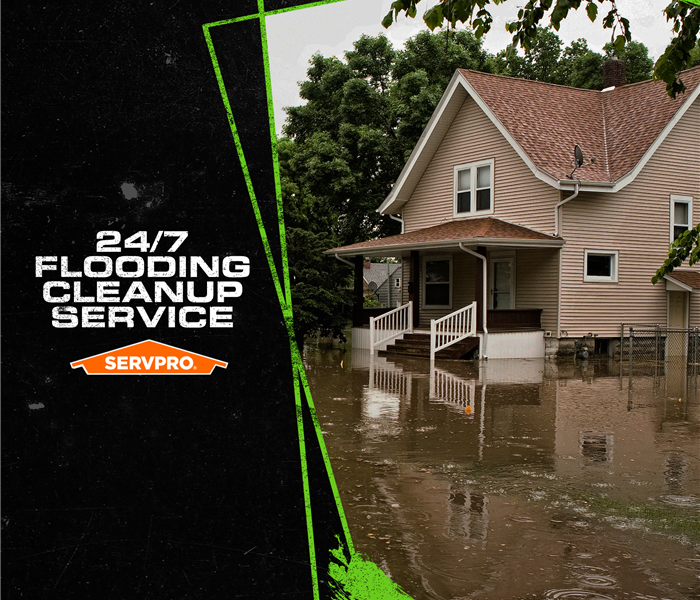 When your house is underwater after a storm, SERVPRO of Lake Stevens is Here to Help® 24/7.
When your house is underwater after a storm, SERVPRO of Lake Stevens is Here to Help® 24/7.
Water Removal Services After Flooding
Lake Stevens has always been an example of a small community that could rapidly increase in size when the region has much to offer. The increase in popularity has much to do with the town being constructed around a massive natural lake that spans more than 1000 acres. It is the largest in Snohomish County and the deepest, reaching 150 feet at points. The attractions of water sports, fishing, and associated recreation made this a famous vacation and travel destination for decades, even when the village was only 900 people in 1960. In the past 60 years, that number has increased to nearly 34,000.
As beautiful and charming as the area might be, there is cause at times for groundwater extraction in Lake Stevens properties. Whether it is quaint and long-standing businesses like the Mansion Inn or newer shopping and retail areas like Frontier Village and Lake Mall Shopping Center, storm damage can be damaging and threatening. Our SERVPRO® professionals are Large Loss specialists throughout the county, from historic buildings like Grimm House to government structures like City Hall.
Flood Cleanup Services for Your Property
Because flooding can occur so quickly in residences and businesses, our storm response team stays ready to respond 24/7. We have skilled technicians to mitigate loss and restore your property to its original state. We can help through every phase of recovery, beginning with surface water extraction with tools like:
- Trash Pumps
- Submersible Pumps
- Vacuums
- Specialty Extractors
As a prominent bedroom community for Everett and even Seattle, Lake Stevens has become an attractive place to call home. However, when flooding occurs after severe weather, you need experienced professionals to make things right. SERVPRO of North Everett / Lake Stevens / Monroe can help when you call (360) 243-8313.
Water Restoration for Storm-Damaged Everett Homes
4/10/2023 (Permalink)
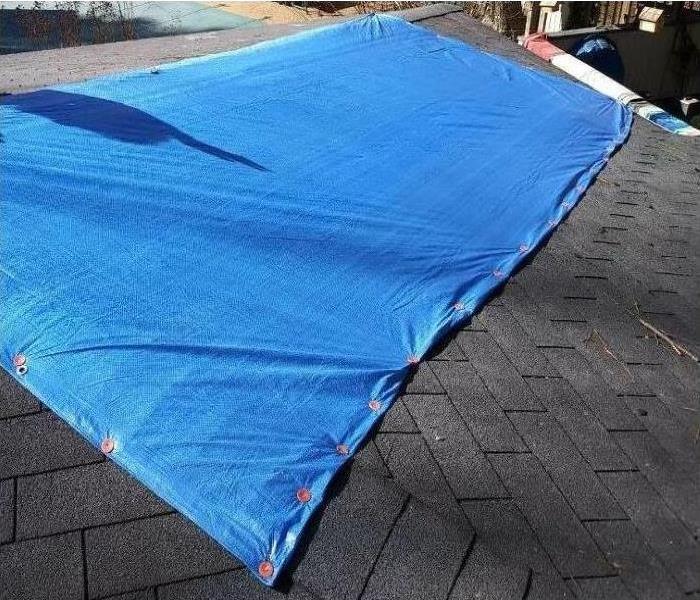 SERVPRO mitigates storm damage by temporarily covering with a blue tarp. Then we can dry the interior of this Everett house.
SERVPRO mitigates storm damage by temporarily covering with a blue tarp. Then we can dry the interior of this Everett house.
Restoring Water-Damaged Structural Systems
Everett homes are constructed of multiple materials, many of which are at least partially porous. After a severe storm event, structural systems with sensitive components become impacted. Our experienced and licensed general contracting crew can repair and recover these areas of the house to make restoration efficient.
Where Is the Storm Damage?
Water restoration for Everett homes after storm losses can mean closely evaluating the house’s condition. No area can be missed when cleaning up the puddling, as persistent moisture can lead to hazardous conditions like mold development. Some of the structural assemblies and systems that can be damaged by storms, flooding, and water disasters include:
- Exterior Wall Systems – Gutter overflows, and poor drainage can see Everett homes get water in lower levels of the house. Extraction and drying are critical in these conditions.
- Roof Assemblies – Storms can impact the roof with water penetration vulnerabilities. Holes or compromise to the roof and its underlayment material give a clear path for water runoff and driven rain to find the attic. We can help with cleanup and repairs.
- Flooring – Losses, where water can pool on the flooring surfaces, can lead to carpeting or wood plank options absorbing the moisture. Effective cleanup involves special extractors and drying mats to preserve the floors.
Thorough Drying for Damaged Systems
While repairs can play an important part in the recovery process, we have many tools and focuses addressing the water effects. The saturation of structural components in wall and ceiling systems can be addressed with focused blasts from centrifugal air movers and effectively placed dehumidification units.
Restoration after storm damage can often mean repairs of the structural systems impacted. Our skilled professionals can assess the damage and return home to its expected structural integrity. Call SERVPRO of Everett / Lake Stevens / Monroe at (360) 243-8313.
Storm Flooding in Everett Causes Layers of Damage
11/8/2022 (Permalink)
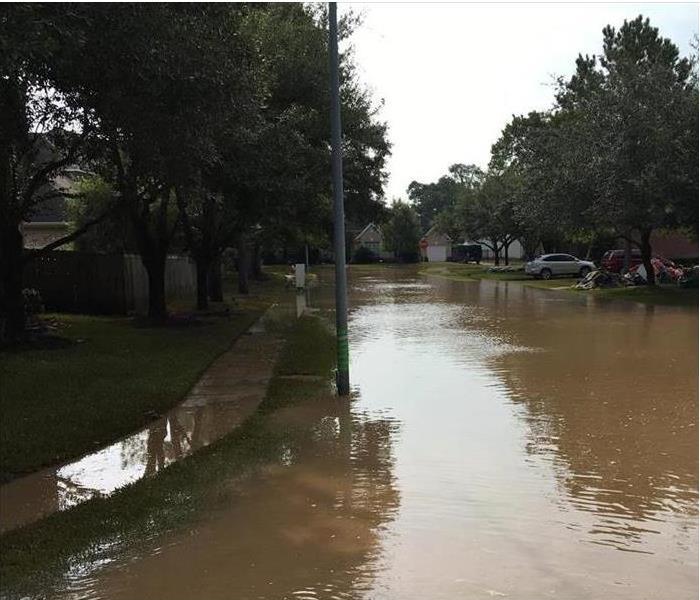 Floodwaters contain contaminants, SERVPRO can safely remove the water and damaged materials from your home.
Floodwaters contain contaminants, SERVPRO can safely remove the water and damaged materials from your home.
SERVPRO Helps Everett Residents with Flood Damage Repair
Flooding during a storm can bring immense damage and costs for Everett businesses and homeowners. Whether you feel flooding is not expected with an upcoming storm or live in an area not tagged as a flood zone, remember that significant storm fronts can change everything. When you have flooding throughout your interior that involves category 3 floodwater with contamination, you need skilled technicians to tackle the cleanup and repair work. This is where SERVPRO comes in – We’re Faster to Any Size Disaster, including emergency response and disaster crews.
Homeowners in Everett with flood damage may need to realize how common it can be. If you are unsure of your risks for flooding, you can consult local flood zone maps to determine if you should take precautions should heavy storms be predicted.
How Does Flood Damage Impact the Home?
Whether you have a basement or crawlspace, floodwater can infiltrate and even wick up into your first floor. Contaminated waters are hazardous, so you must reduce risks by keeping people and pets away from them until SERVPRO arrives for water removal services.
- Contamination – Floodwaters harbor many contaminants, including chemicals, vermin, fecal matter, fuel, and more.
- Structural Hazards – Damage to structural elements like flooring or support beams can occur from water pressure during the flood.
- Odors – Musty, foul odors could develop from floodwaters or mildew growth. These odorous particulates must get addressed by skilled Odor Control Technicians (OCT).
SERVPRO arrives at your door within four hours or less with each emergency flooding or water damage call. We begin the assessment, containment, and water removals using pumps and extractors to handle all standing water and debris. Our crew also sets up drying equipment and dehumidifiers in tandem to help quickly restore relative humidity to bring down moisture levels. We repair or replace building materials and finishing touches as needed to make everything “Like it never even happened.” – General Contractor License #: SERVPES871RD
Request help online or call SERVPRO of Everett/Lake Stevens/Monroe at (360) 243-8313 whenever you require flood damage assistance.
Storm Damage Recovery In Your Lake Stevens Home
7/17/2022 (Permalink)
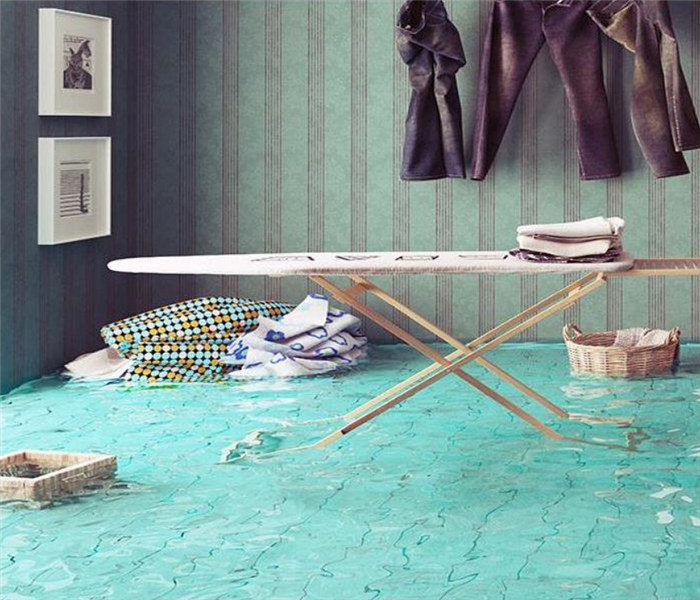 When storm damage affects your home, the situation can escalate fast. Call SERVPRO to quickly come out and start the water removal process.
When storm damage affects your home, the situation can escalate fast. Call SERVPRO to quickly come out and start the water removal process.
Start to Finish Storm Damage Recovery in Lake Stevens
Residents of Lake Stevens, just east of Possession Sound, have or hear stories of severe storms in the area. Wind gusts and rains can wreak havoc with the roof and exterior structure of your home. Once the shell of your dwelling breaches because of shingles and decking ripping off the roof or a tree limb crashing into siding or a window, the inevitable happens. Copious quantities of precipitation pummel your damaged home, pouring in and causing water loss throughout.
Emergency Response
When our emergency crew arrives to scope the storm damage in your Lake Stevens home, the first concern is securing the structure, inside and out. Boarding and tarping up exterior damage ensures that additional rain does not enter your home. We address this as our project manager begins assessing safety concerns inside. Before our technicians can commence water extraction and structural drying, stabilizing floors and evaluating ceilings for hidden water is vital. Our build-back team has exceptional skills in this area. We might need to manage these risks without the help of your residence’s electricity for a time as electric shock hazards are non-negotiable.
Water Extraction
Once the structure stabilizes, the SERVPRO team begins removing the water. We choose among submersible pumps, ideal for water deeper than two inches, and truck-mounted or portable extractors to get the job done. The mounted equipment has a higher capacity and the benefit of an on-board power generator if the lights are still out. Portable extractors allow us to get into tight areas, and limit the aggressive nature of the bigger units where surfaces beneath the water need finesse. We aim to extract all the liquid water possible before moving to the drying phase. Throughout the extraction, our staff captures and contains contaminated floodwaters for lawful disposal.
Structural Drying
SERVPRO Applied Structural Drying (ASD) certified technicians complete a rigorous course of classroom and hands-on work from the Institute of Inspection Cleaning and Restoration Certification (IICRC). We approach drying scientifically, balancing air movement and temperature to evaporate water trapped in structures so that our carefully curated fleet of dehumidifiers can capture it.
Rebuilding
Our general contracting division awaits the chance to repair and rebuild both interior and exterior structures. SERVPRO’s inclusion of a reconstruction option streamlines the restoration of your storm-damaged home, saving time, money, and stress.
Waste no time contacting SERVPRO of North Everett / Lake Stevens / Monroe after a storm damages your home. Our phone at (360) 243-8313 is answered 24/7, and we pledge to respond fast and with the workforce and equipment to get the whole project completed promptly.
What You Can Do For Your Everett Home When Flood Damage Strikes
6/17/2022 (Permalink)
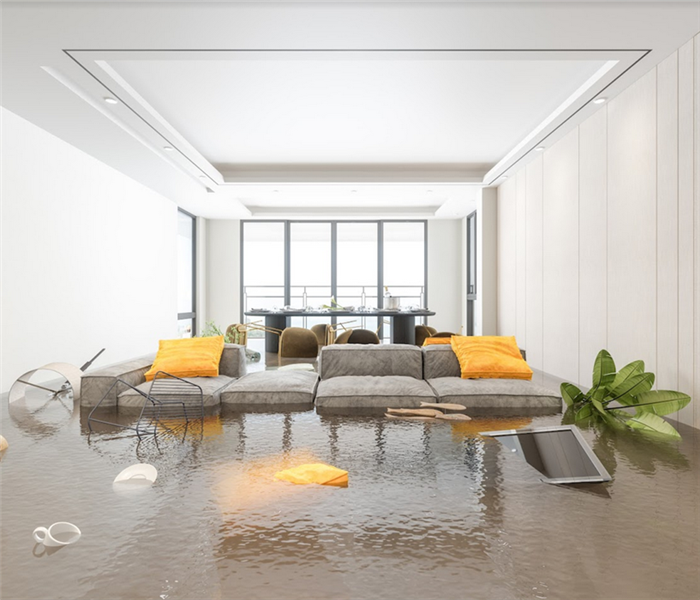 Flooding can often overtake your home and damage the structure and contents. Take control of the situation by contacting SERVPRO. Call us 24/7.
Flooding can often overtake your home and damage the structure and contents. Take control of the situation by contacting SERVPRO. Call us 24/7.
SERVPRO can help you smooth out the process for your Everett storm damage.
When you see a weather report of a severe thunderstorm coming during the night, most people would hardly expect it to lead to flood damage inside of their home. However, sometimes luck can fail, and an unfortunate accident can occur inside of your home. In these moments, it is essential to reach out for professional help as soon as possible. Quick reaction times mean a better chance for a smooth remediation process.
Storms can bring intense winds, and those winds can cause damage to the outside of your Everett home and allow flood damage inside. Hypothetically, let's say that one of your windows is forced open by the storm's strong winds. Throughout the night, rainwater was able to get inside of your home and flooded your dining room floor.
Reaching out for professional help as soon as you find the damage is the best thing you can do for your home. Quickly cleaning up the water can prevent future complications, such as mold damage. If mold damage is left unchecked, it can cause rot to the structure of your home, which is never a good thing.
When you get in contact with SERVPRO, our technicians always respond swiftly. We can gather a team of talented water damage restoration technicians (WRT) and send them to your home as soon as possible. However, our arrival may be delayed depending on weather conditions. Even if flooded roads or fallen trees, our technicians are still dedicated to arriving at your home and helping you remediate the flood damage inside.
Once we arrive, SERVPRO can investigate the flood damage inside of your dining room and create a water extraction, clean up, and drying plan. We can use wet/dry vacuum and rover-mounted extractors to clean up the standing water. From there, we can use antibacterial cleaning agents to wipe down your floor and walls. After searching for extra pockets of water with our thermal imaging cameras, we can set up a drying environment using devices like flood-drying mats and dehumidifiers. Here at SERVPRO, we're thorough and dedicated to leaving your home, "Like it never even happened."
If sudden flood damage strikes your home, get help immediately. Reach out to SERVPRO of North Everett / Lake Stevens / Monroe by dialing (360) 243-8313 on your phone. We can send techs right away and help you.
You Need Professional Help After Flood Damage in Everett
5/11/2022 (Permalink)
 Contact SERVPRO at (360) 243-8313 for storm damage cleanup and restoration for all Everett area properties
Contact SERVPRO at (360) 243-8313 for storm damage cleanup and restoration for all Everett area properties
Is Floodwater in Everett Considered Contaminated?
Storms featuring "microbursts," short-term but torrential rain events, are unfortunately familiar to residents of Everett. If the storm sewer system near your home cannot handle the influx of water, you can be on the receiving end of significant amounts of liquid flooding and an alarming load of silt, mud, and other debris. Managing the incursion is an urgent matter, requiring a team approach. Homeowners are wise to reach out to us for assistance.
Contaminated Flood Waters Need Professional Management
When flood damage invades your Everett home, the water is by definition contaminated. Heavy rains exacerbated by a saltwater surge, collected overland drainage from elevated areas around the city, and a rise in the level of the Snohomish River can all contribute to dirty, dangerous water. The mix's substances and debris include sewage, deceased animals, landscaping and pavement treatment chemicals, vegetation, and soil.
Collection, containment, and disposal of the contaminated floodwater need the training, knowledge of local hazardous waste requirements, and experience our managers and technicians bring to the scene. Cleaning and treating affected surfaces with EPA-registered disinfectants guard your family against lingering pathogens or mold growth.
We Have the Training and the Equipment
SERVPRO invests in both state-of-the-art equipment and Institute of Inspection Cleaning and Restoration Certification (IICRC) training. The investment ensures our crews respond to your flood crisis using the disaster recovery industry's best practices. We shovel solids like mud and silt to make water extraction easier. Our service vehicles stock the commercial-grade submersible pumps and water extractors necessary for flood water removal. The team selects and operates the equipment until visible water evacuates entirely.
Moisture Detection Is the Key to Thorough Drying
Sensitive probes and meters evaluate moisture levels in structural components to provide baseline data for drying. Thermal imaging locates the migration of water behind walls or in other recesses. SERVPRO might determine to make flood cuts to release water for removal and reduce drying times. Our Applied Structural Drying (ASD) technicians design a configuration of air movers, heaters, and dehumidifiers to restore normal moisture readings.
We Offer Rebuilding and Restoration Services
Our General Contractor License allows us to repair flood damage, offering you wrap-around services without hiring additional contractors. Any controlled demolition we used to mitigate and remediate can be rebuilt as well.
SERVPRO of North Everett / Lake Stevens / Monroe stands ready to help with your flooding crisis from initial assessment through any needed reconstruction. Call our emergency line at (360) 243-8313 day or night.
Don’t Let Costly Storm Flood Damage Ruin Your Lake Stevens Property
1/10/2022 (Permalink)
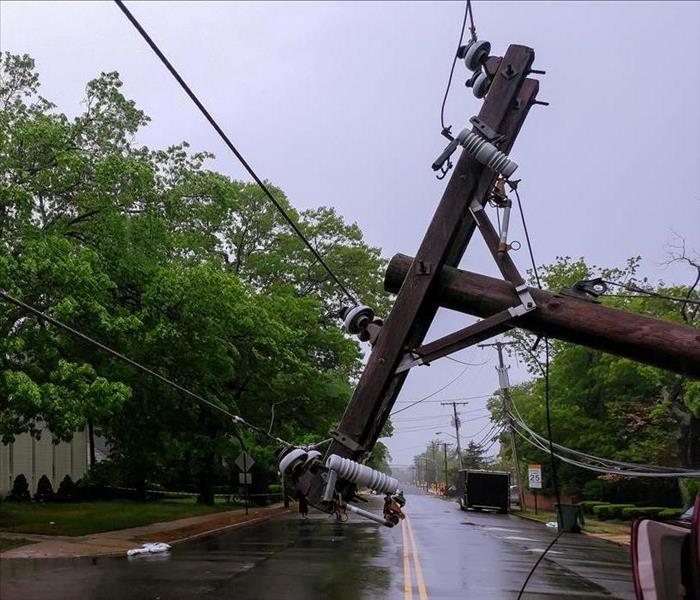 SERVPRO can provide temporary electrical power when mitigating flood-damaged properties in Lake Stevens. Be aware of electrical risks.
SERVPRO can provide temporary electrical power when mitigating flood-damaged properties in Lake Stevens. Be aware of electrical risks.
SERVPRO Helps Lake Stevens Residents Recover from Storm Flood Damage
When storm flooding comes through the Lake Stevens area, there are many things that may cause worry. What may have been in the forecast as light rain can turn into heavy rains and flash flooding, which leaves your property vulnerable to roof damage, groundwater intrusion, and possible flying debris. One thing that area residents can count on when they get dealt a blow with flooding is the team at SERVPRO. We’re Faster To Any Size Disaster, meaning we are ready to mobilize and arrive at your property within hours of your call so that we can begin flood mitigation.
When it comes to storm flood damage in Lake Stevens, homeowners may not realize the potential for damaged home electrical systems. It is essential to know that simply replacing your outlets may not solve the problem after a storm flood event. There could be hidden moisture and other issues that call for skilled technicians, both from the electrical and restoration field.
SERVPRO will:
- Arrive at your door and perform a thorough assessment
- Our crew chief puts a plan of action in place to begin water mitigation and drying
- Controlled demolition gets performed to remove unsalvageable building materials to replace them with new materials – General Contractor License #: SERVPES871RD
- When electrical issues are suspect, SERVPRO ensures the best local electrical contractors inspect to determine the proper remedy
Flood damage is often a concern with many people and whether everything is covered. SERVPRO will take the time to ensure all paperwork is for your claim and work directly with your insurance agency. It is all about cutting the stress and taking weight off your shoulders as we work to restore your property to pre-flood condition.
Contact SERVPRO of North Everett/Lake Stevens/Monroe when you require flood damage assistance after a recent storm front. You can reach out to us any time, day, or night, by dialing (360) 243-8313.
Extreme Winter Weather Creates a Need for Water Damage Restoration in Everett
12/22/2021 (Permalink)
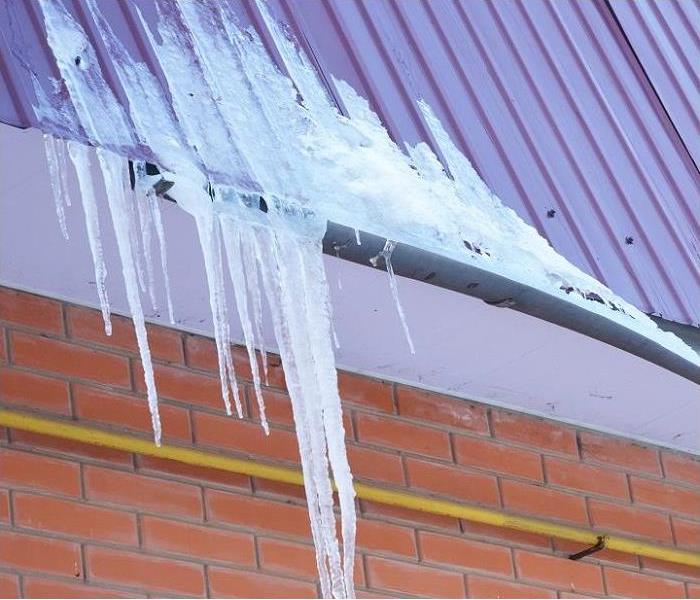 Situations like frozen pipes and ice damming can be some of the most destructive and threatening during the winter season.
Situations like frozen pipes and ice damming can be some of the most destructive and threatening during the winter season.
There are Many Ways Severe Winter Conditions Can Cause Harmful Situations for Everett Homes
In the Pacific Northwest, heavy snow and low temperatures are hallmarks of the winter season. When combined with harsh winds during extreme weather events, structures like your home could become threatened. Our SERVPRO professionals can help with cleanup and water restoration after winter weather damages.
Preventing Winter Damage Events
Situations like frozen pipes and ice damming to Everett homes can be some of the most destructive and threatening during the winter season. Understanding conditions that can cause this damage, and methods of preventing it, is essential.
- Burst Pipes and How This Damage Can be Prevented - Cold snaps can be particularly hard on exposed plumbing fixtures and pipes throughout a property. Poorly insulated service lines can freeze under these rapidly dropping temperatures, making preventative care critical to keep homes from experiencing a disaster like a burst pipe. It is possible to prevent these emergencies' impact on the exposed water line. In most cases, determining susceptible pipes shows where the situation calls for better insulation. We also encourage homeowners to circulate warm air through the property, especially around sensitive plumbing.
- Ice Damming and How This Damage Can Be Prevented -These threats can form rapidly, ultimately breaking the bonds of roof shingles and allowing snowmelt water to penetrate the attic. The worse the conditions result in, the more structural and flood damage. Like frozen pipes, ice damming can also be prevented with some initial actions. Evaluating the condition of insulation of the attic is an excellent place to begin, though direct measures might require installing heated cables on the eaves to inhibit ice formation.
How Can SERVPRO Help?
Over the years, many have come to trust the reliable response of our SERVPRO team to help with emergencies. Pipe bursts and attic flooding have similar urgencies, so our professionals arrive fast with extraction and drying tools to protect the structure and restore the effects of the disaster.
The winter months can add beauty to the area. Winter can also threaten homes and businesses when severe weather conditions set in. Our SERVPRO of North Everett / Lake Stevens / Monroe team can help when you call (360) 243-8313.
Removing Floodwater from Finished Basements of Lake Stevens Homes
11/22/2021 (Permalink)
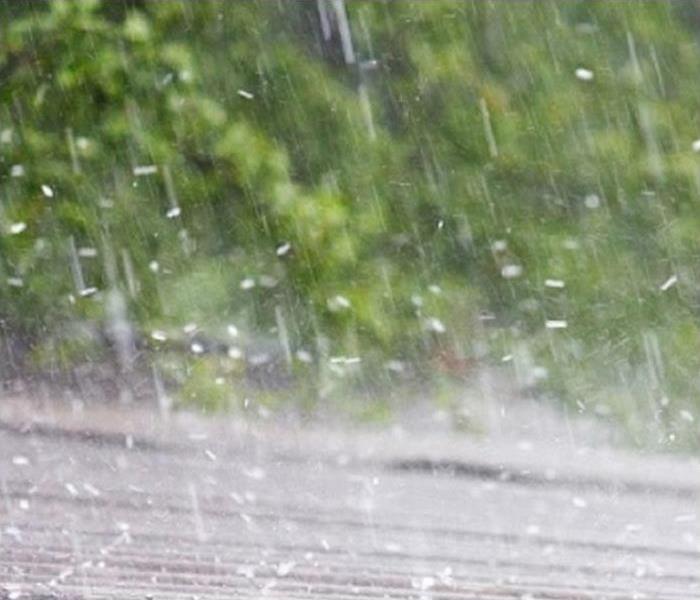 Flash flooding can happen at anytime. SERVPRO is always on call for storm damage restoration services.
Flash flooding can happen at anytime. SERVPRO is always on call for storm damage restoration services.
Fast Action is Vital to Removing Threatening Water From Lake Stevens Properties
Lake Stevens homes and businesses can quickly fall victim to flooding damage, especially when flash floods rapidly form and spread in the neighborhood. Finished basements are an everyday staple of modern homes in the area, heavily impacted by infiltrating floodwater. Our SERVPRO team can help with rapid mitigation solutions.
Finding the Penetration Point
One of the key elements to restoring flood damage for Lake Stevens homes is finding where the water is getting into the house. As an experienced restoration team and licensed contractor, we can use this knowledge to focus on drying and mitigation actions and offer repairs and build-back services to vulnerable points.
Extracting Standing Water from the Basement
Standing water can be among the most persistent threats to basement levels. When flooding occurs, pooling can fill the entire space through structural openings. Finished basements often have carpeted flooring, which can become oversaturated and still leave pooling on the surface. Water extraction and removal involves several devices from our inventory, including:
- Pumps
- Vacuums
- Weighted extractors
Clearing Trapped Water from Porous Materials
Water can quickly become trapped within materials or structural cavities present in the basement. The longer this moisture stays within the materials affected, the more unlikely restoration becomes. Trapped water can quickly become ‘bound water,’ a term used when porous materials absorb moisture. When water becomes bound, it affects the composition of the hosting material and makes it unsalvageable.
Flooding is a fast-moving and threatening situation for area homes and businesses. As a leading restoration team in the area, we have a storm response team available 24/7 to help when disasters impact your property. Our SERVPRO of North Everett / Lake Stevens / Monroe team can make it “Like it never even happened,” when you call (360) 243-8313.
Flood Restoration in Lake Stevens Can Be a Minor Job
9/21/2021 (Permalink)
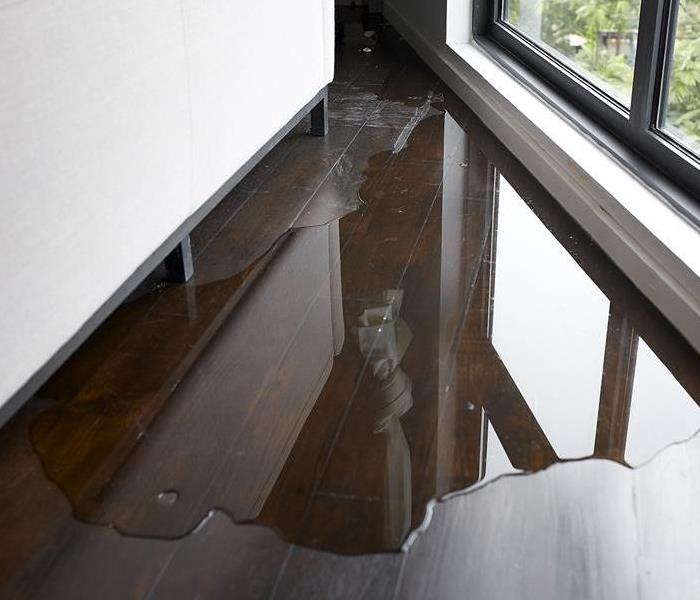 Storm damage can get the best of you if you're not careful. Call SERVPRO of North Everett / Lake Stevens / Monroe today.
Storm damage can get the best of you if you're not careful. Call SERVPRO of North Everett / Lake Stevens / Monroe today.
SERVPRO Provides Water Removal Services in Lake Stevens
Sliding glass doors can be a very nice addition to your home. Having an extra-large window in your house can allow you to enjoy the outdoors sites while you are in your living room. However, the upper and lower seals on the glass doors can get worn as time goes by. If you happen to experience a heavy rainstorm, there is a chance water can leak into your house via the sliding glass door seals.
Anytime water gets into your dwelling from the outside, it could cause flood damage in your Lake Stevens home. Moisture coming from the outdoors can be contaminated by harmful bacteria, viruses, or fungi. Therefore, even if it doesn't seem like a lot of water leaked in from your sliding glass doors, it is wise to call in a professional company such as SERVPRO. We are available 24/7, and we can assist with the following services:
- Emergency Services for Water Damage
- Water Damage Repairs
- Ceiling Repairs from Water Damages
- Fix a Leaking Roof from Storms
- Basement Flooding Cleanup
- Flood Restoration
Since water will follow gravity, the first place it will go when it gets in through old glass door seals is your flooring. If you have hard-surfaced floors, there is a good chance that the cleanup will be minor. But, if any of your carpets got wet from the leak, they will have to be replaced due to the possibility of water contamination.
If enough rainwater made its way into your house, sections of your drywall could have also gotten wet. To find out, we can use a penetrating meter to test moisture content and see if it is higher than other unaffected sections of your drywall.
If you ever step in a puddle near your sliding glass door after a storm, call SERVPRO of North Everett / Lake Stevens / Monroe at (360) 243-8313.
What Can Everett Homeowners Expect from Flood Damage in their Home?
8/26/2021 (Permalink)
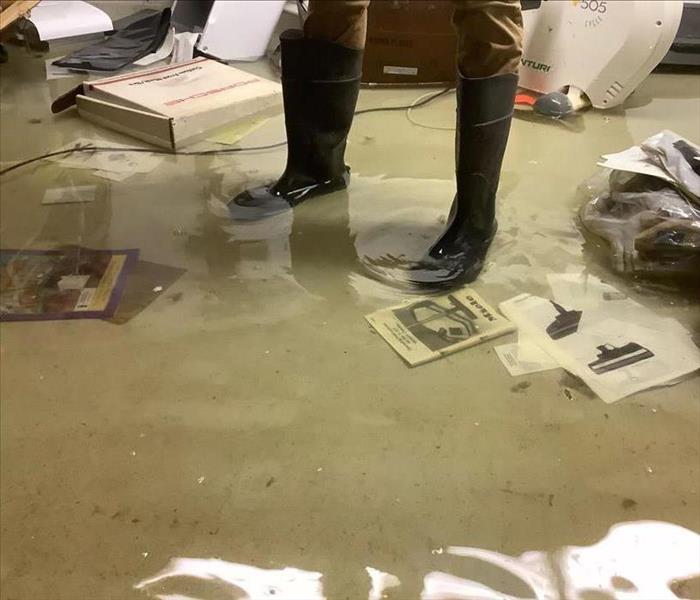 You want experienced hands working on your property after a flood occurs. Call SERVPRO for assistance with flood remediation.
You want experienced hands working on your property after a flood occurs. Call SERVPRO for assistance with flood remediation.
SERVPRO Technicians Have the Training to Handle All Types of Water and Structural Damage to Everett Properties
Intense weather can deliver a host of water damage and other problems to Everett homes. Another common occurrence that property owners deal with such as fires from lightning strikes and damage from tree limbs hitting roofs or flood water entering a home.
When flood damage occurs in an Everett property, cleanup needs to begin as rapidly as possible to minimize the damage to the property. Homeowners often notice that the water recedes as rapidly as it enters and assumes all they need to do is set up fans to dry the walls and floors. However, this can be a huge mistake for a few reasons:
- Water trapped in floor joists can create foul odors
- It can set up an environment favorable for mold growth
- Water wicked into sheetrock can destroy floors and ceilings on lower levels
SERVPRO technicians plot the course of the flood water within the structure and take action to halt the migration and seepage into walls and floors. This lessens the amount of damage done and saves the homeowner the cost of replacement for building materials. In cases where portions of walls or ceilings require removal due to water damage, SERVPRO techs can repair them post-mitigation with ease.
Drying the property involves using different types of drying equipment, including the use of industrial dehumidifiers. These are some of the most important aspects of the water damage mitigation drying phase as it lowers the interior humidity levels to below sustainable levels for mold growth.
SERVPRO of North Everett / Lake Stevens / Monroe at (360) 243-8313 is available 24/7 to clean up and restore homes affected by flood damage in Everett.
What Immediate Mitigation Actions are Universal to All Lake Stevens Flooding Events?
7/30/2021 (Permalink)
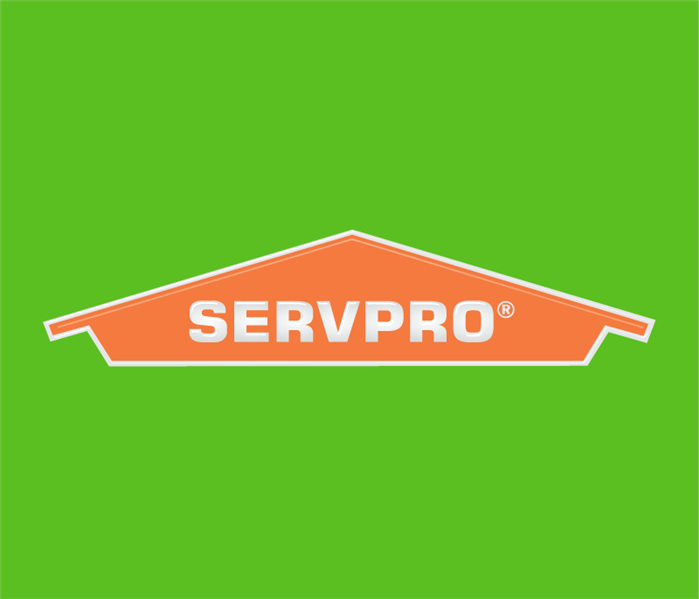 Floods impact property to a point of no recovery. SERVPRO has you covered from start to finish for all storm damage restoration.
Floods impact property to a point of no recovery. SERVPRO has you covered from start to finish for all storm damage restoration.
Certain Restoration Practices Are Needed for Nearly All Flood-Damaged Lake Stevens Homes.
While the causes and the potential damage to homes and businesses after flooding might vary, specific cleaning and restoration actions are necessary for each of these impacted properties. Our experienced SERVPRO professionals mobilize quickly after floods to get these efforts started.
What Are the First Steps SERVPRO Takes After Flooding?
Addressing flood damage in Lake Stevens homes begins with mitigation actions. Our responding SERVPRO team can get multiple processes started quickly to reduce the cost and time of restoration:
- Extraction – Extraction must come first in much of the restoration and mitigation process, as standing water can devastate affected building materials.
- Establishing Power – Flooding situations can often leave structures without suitable power to supply the machines and devices necessary for extraction, cleaning, and deodorization. Trailered generators and portable power provide temporary electricity when required.
- Protecting Belongings – Flooding can often target the personal belongings and contents of your home that have no replacement. With rising waters and spreading moisture concerns, we can focus on relocating affected items and cleaning when necessary.
Flooding can be one of the most devastating situations that many area homes and businesses face in their lifetimes. Because these situations develop rapidly, our SERVPRO of North Everett / Lake Stevens / Monroe team is available 24/7. Give us a call today at (360) 243-8313.
Storms can Bring Flooding and High Winds to Everett
3/17/2021 (Permalink)
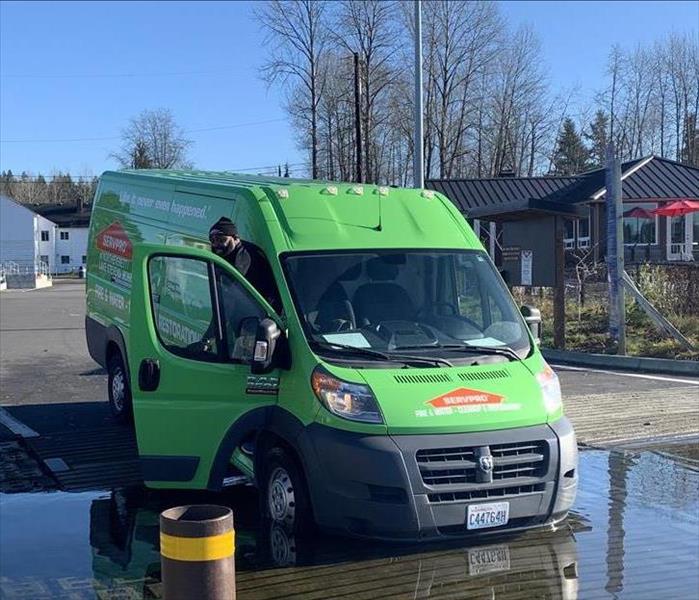 When a winter freeze and storm visit your Everett, Call SERVPRO, our trucks are standing by.
When a winter freeze and storm visit your Everett, Call SERVPRO, our trucks are standing by.
SERVPRO provides flood remediation after snow or freezing events in Everett
Storms that pour rain and snow down onto Everett can create dangerous situations to quickly arise. Rain can cause flooding, and snow, if dense enough, can cause a white-out along with structural damage. While at home, white-outs are only interesting, but if you are out driving, it is best to pull as far over to the right on the roadway and leave your hazard lights flashing.
How to Protect Your Everett Home from Freezing Storms and Roof Leaks
Everett storm damage needs professional restoration and cleanup
Dense, heavy snow can create serious problems for your roof, and the best defense is to ensure that your attic’s insulation is correctly installed. This can control the temperature transferences and reduce the risk of ice dams. This insulation does not make the roof stronger but it makes water, ice, and snow less capable of forcing their way into your home.
After a severe storm passes, concerned homeowners might want to check the following:
- The interior of their attic for leaks, particularly between sections of underlay,
- Frozen pipes, especially for those that have sections running along exterior walls, and
- Exterior areas that might have suffered wind damage.
These checks should not take long and doing so can prevent costly future problems.
If your home needs services related to flood or storm damage, call SERVPRO of North Everett / Lake Stevens / Monroe at (360) 243-8313. We can help with water cleanup, also, making it stress-free for you and your family.
Can Debris Be Removed from a Lake Stevens Home After a Flood?
2/23/2021 (Permalink)
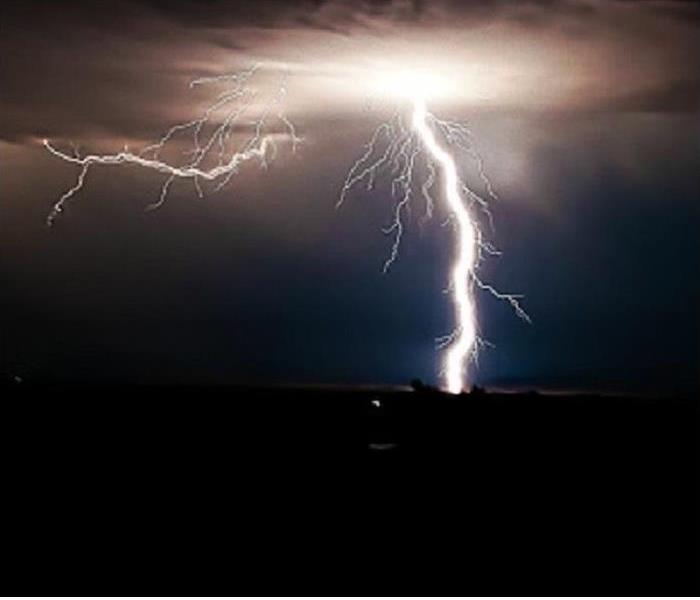 Flooding often results in water in basements. SERVPRO is equipped to dry your basement!
Flooding often results in water in basements. SERVPRO is equipped to dry your basement!
SERVPRO Professionals are Experts in Mitigating Storm Damage
Floodwaters in Lake Stevens can bring contaminated water, silt, and debris into your basement. You not only have the contents of the basement floating around, but all sorts of things are swept in the rising water. It is a cesspool of health hazards with everything from:
- Dirt
- Dead animals
- Chemicals
- Medical waste.
Dealing with Black Water and Debris Removal in Lake Stevens
Our IICRC certified technicians can clean up the muck in your basement. We have the proper PPE and experience to handle what may look like a lost cause. There are some of the things they do:
- Removing debris and mucking out with rakes and shovels
- Using truck mounted trash pumps that can handle debris
- Submersible pumps help with water extraction
- Use EPA approved antimicrobial and disinfectants on impacted areas
Restoring Your Basement to Pre-Loss Condition
Once everything is removed from your basement, we begin more in-depth cleaning and restoration. Some things cannot be salvaged in a flood situation, such as carpet and padding. We restore as much as we possibly can and always strive to return your home, “Like it never even happened.”
For flood damage help in Lake Stevens, contact SERVPRO of North Everett / Lake Stevens / Monroe at (360) 243-8313.
In the Lake Stevens Area, Treat Yourself to an Evening Dedicated to Local Art.
1/25/2021 (Permalink)
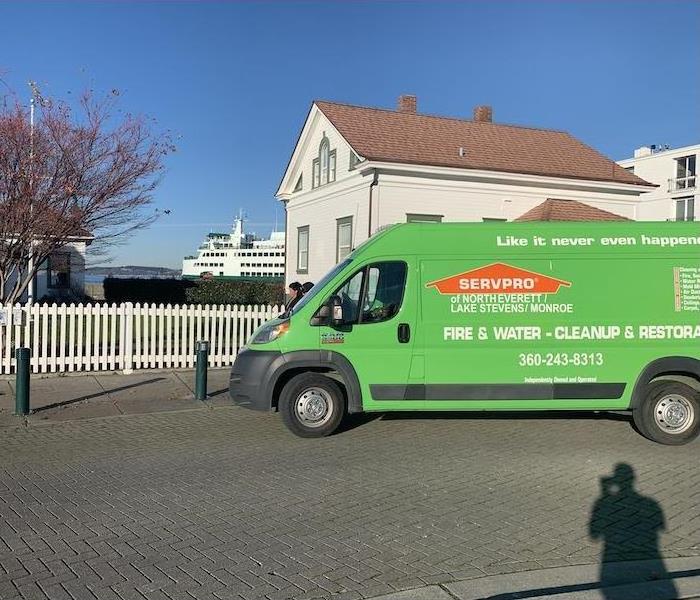 Storms may cause a lot of havoc to your property. Call the professionals of SERVPRO for the storm mitigation services needed.
Storms may cause a lot of havoc to your property. Call the professionals of SERVPRO for the storm mitigation services needed.
Visit the Everett Art Walk Near Lake Stevens.
If you are interested in checking out what local Lake Stevens area artists have to offer, visit the nearby Everett Art Walk. The event is routinely held the third Thursday of every month, from 5 to 9 PM, and includes offerings from various art centers, galleries, and studios along Hewitt Avenue in downtown Everett. Before visiting the art walk, you should consider the following:
- The event is free and open to the general public
- The art walk’s website has important updated details concerning the activity
- Vendor participation may change and, on certain days, the activity might be canceled
With all this in mind, area residents can properly plan their evening of local culture and avoid potential disappointment.
As fellow supporters of northwestern Washington’s art and culture, SERVPRO of North Everett/Lake Stevens/Monroe is honored to inform you of this exciting offering. Also, as your neighbors, we would like to remind you that we are always here to help you recover from flood damage. Contact us whenever you need us at (360) 243-8313.
Show Your Support for Everett Small Businesses This Weekend
11/23/2020 (Permalink)
 We look forward to showing our support for Everett Small Businesses!
We look forward to showing our support for Everett Small Businesses!
After the Bustle of Mainly Online Black Friday Shopping, You Have the Opportunity to Partake in a Vital Small Business Saturday here in Everett.
More than ever before, small businesses are trying to stay afloat in the country's pandemic landscape, and events like Small Business Saturday can help keep these businesses in the black. In the Vertical Gardens Northwest, representatives from the Everett Makers Market will conduct an outdoor pop up to promote their wares and products.
If you have not seen many of the retailers and craftworkers of the Everett Makers Market, you can help to support these trades and small businesses with price specials and unique offerings you will not find anywhere else. The pop up will occur on Saturday, November 28th, 2020, at 12 noon to 5:00 PM.
While local artisans might not have the answer for flooding in basements of Everett homes, our SERVPRO of North Everett / Lake Stevens / Monroe team can help with fast extraction, cleaning, and drying. Give us a call today at (360) 243-8313.
Is it Possible to Dry Wood Floors after Flood Damage in Everett?
10/29/2020 (Permalink)
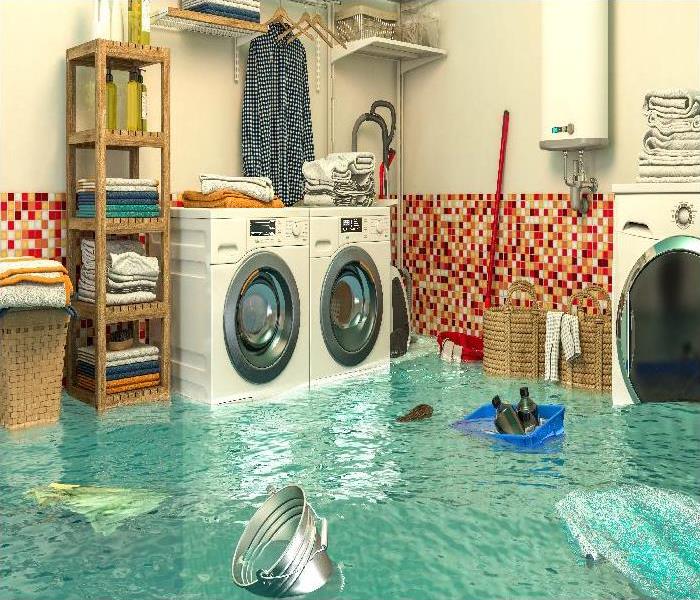 “Like it never even happened.”
“Like it never even happened.”
Everett Homeowners do not Want to Pay for Replacement Floors after Flood Damage
Everett enjoys a charming location near Possession Sound, and thankfully the weather is a little less extreme than in inland areas. However, the area can still suffer from heavy rain, wind, and storms, causing damage to homes.
If you happen to have a wood floor in your Everett home, flood damage is bad news. Wood floors look fantastic, but they can be costly, and replacing them is more complicated than laying new carpet. Thankfully, a storm does not have to be a death knell for your hardwood floors. SERVPRO is on hand to help restore them.
What does floodwater do to wood floors?
Floodwater is not kind to wood floors. It can:
• Soak into the boards and cause them to buckle (curve up) or cup (bend down)
• Make the boards warp totally out of shape
• Leave boards damp and at risk of fungal growth – mold needs moisture to grow, and it can feed on the wood
• Leave behind bacteria or other unsanitary nasties
What can SERVPRO do to save your floor?
Fast action is essential if you want to save your floor. The longer water sits, the more damage it can do. Call us as soon as you can after flood damage – We’re Faster to Any Size Disaster.
Once we arrive, we can:
• Use pumps to suction away standing water
• Use drying mats for quick and gentle drying
• Position air movers and fans to evaporate water from the boards
• Place dehumidifiers to reduce humidity
Why are the drying conditions vital?
Wood floors are delicate, and it is essential to dry them carefully. If we dry too slowly or not thoroughly, that increases the risk of rotten wood or fungal growth. If we dry too quickly, the boards might dry out and splinter.
We train our technicians to calculate the ideal drying conditions for your floor and set up equipment accordingly. We also monitor moisture and humidity levels in and around the floor as we work to ensure readings stay stable.
Do not let floodwater ruin your wooden floors. Call SERVPRO of North Everett / Lake Stevens / Monroe at (360) 243-8313.
Why Does Sheetrock Warp and Buckle After Water Damage in Monroe?
9/26/2020 (Permalink)
 Begin the cleanup of flood damage as fast as possible by calling SERVPRO of North Everett / Lake Stevens / Monroe at (360) 243-8313.
Begin the cleanup of flood damage as fast as possible by calling SERVPRO of North Everett / Lake Stevens / Monroe at (360) 243-8313.
SERVPRO techs have advanced water restoration equipment to assist with cleaning up after storm damage in your Monroe home
Water is always trying to enter your home. If there is a damaged seal, a threshold that needs repair, poor drainage, or other potential hazards around your Monroe home, eventually heavy rains can bring a significant amount of damage. Once inside, the water tends to recede rapidly; however, sheetrock in particular fares poorly when exposed to excessive moisture that gets wicked; signs of distress from absorption include:
• Buckling or tearing
• Visible water spots
• Swelling or warping
Can Sheetrock Get Restored After Flood Damage?
Even a small amount of flood damage in your Monroe home can result in substantial deterioration of your walls and flooring. When water wicks into the sheetrock, there is a short window of time to get dried and remain in place.
Damaged sheetrock has no restoration potential and requires removal. However, to minimize the number of walls or ceilings that need replacement, SERVPRO techs utilize controlled demolition actions known as flood cuts to halt any further damage from the water. The techs use their moisture detection equipment to locate the highest watermark on the building materials and then cut the wall portion off using straight cuts.
When it is time for repairs, rather than undergo the expense for replacing entire walls, carefully measured and cut pieces of sheetrock get installed, and then the seams get covered in a joint compound which gets sanded after drying. After priming and painting, the result is a wall with zero signs of the previous flood damage.
This SERVPRO carries a general contractor license #SERVPES871RD and can provide a myriad of rebuilding services to repair the property post-water damage mitigation. This service saves homeowners from the stress of finding someone to do the repairs after the water damage restoration completes.
Begin the cleanup of flood damage as fast as possible by calling SERVPRO of North Everett / Lake Stevens / Monroe at (360) 243-8313. The techs are available 24/7 to return your home to its pre-flood condition.
How do I rebuild after a flood in Everett?
5/28/2020 (Permalink)
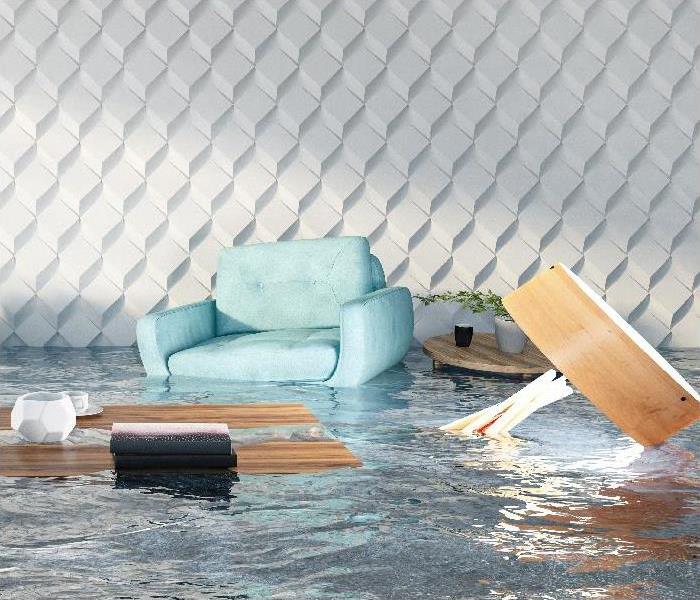 Rebuilding a property can be a time-consuming process.
Rebuilding a property can be a time-consuming process.
Flood Damage recovery and restoration are available to residents in Everett within four hours of notification of loss with SERVPRO
Can floods cause structural damage?
In the US, floods cause billions of dollars worth in damages every year. As little as two inches of rushing water has the strength to uproot trees, flip vehicles, and burst through doors. A flash flood can harm an Everett property by damaging doorways and windows and sending debris against the mortar. Once inside a property, external and internal standing water can exert significant pound for pound pressure against jointing, walls, and floors. In a worst-case scenario, floods can cause some or part of your home to collapse. Equally, performing restoration without the experience of structural risks in a flooded property can be dangerous for both the structure and yourself.
How do I repair structural damage in a flooded property?
• Scope the property for any safety issues and shutoff mains electricity as well as gas
• Extract water from the property using submersible pumps and water extraction equipment
• Clean and disinfect the property thoroughly, then remove any non-salvageable materials
• Create a sound drying strategy to eliminate residual moisture
• Perform structural repair and reinstallation of any non-salvageable material
Do I need to use a general contractor as well as a restorer for flood recovery?
Restorers mitigate loss after a flood, preparing your property for repair by making it safe, secure, and sanitary. Depending on your restorer, you may need to enlist a general contractor separately to perform rebuilding and remodeling work. Third-parties are also useful if you need specialist repair to plumbing or electricity. SERVPRO has in-house technicians with qualifications in general construction (OSHA), so you only have to deal with one point of contact from start to finish.
Rebuilding a property can be a time-consuming process. Contact SERVPRO of North Everett / Lake Stevens / Monroe at (360) 243-8313.
For more about Everett click here.
How Did My Roof Get Damaged During the Storm?
5/13/2020 (Permalink)
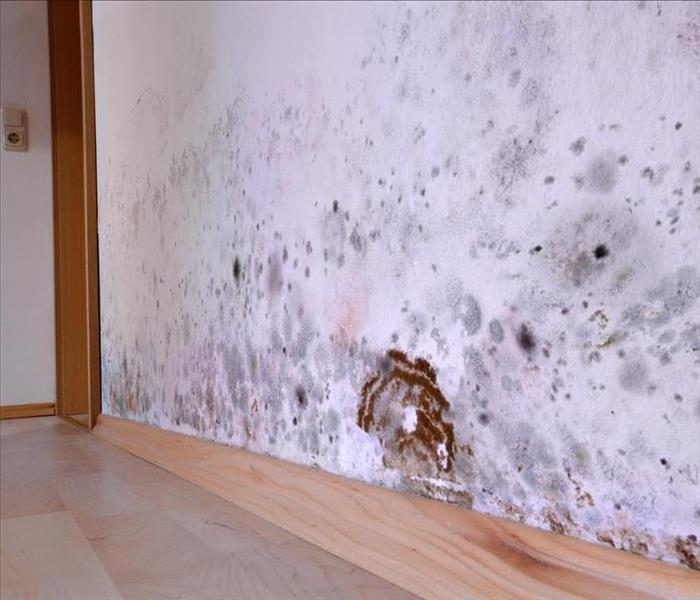 Does your Everett building have mold growth from after the storm? Call SERVPRO to mitigate your problem.
Does your Everett building have mold growth from after the storm? Call SERVPRO to mitigate your problem.
Real-Time Solutions to Damaged Everett Structures is a Cornerstone of SERVPRO Services
With the level of destructive storms that can reach this area of Everett and Greater Seattle, our restoration team must remain diligent in responding to these emergencies as they happen. The sooner that our professionals can reach a storm/flood-damaged home, the less likely irreparable damages are overwhelming. Structural damages are among the most consistent concerns after a fierce weather event, and the roof is often the most vulnerable of these areas.
Identifying and resolving storm flood damage in Everett homes is more than just extracting water and drying up saturated materials. In many cases, the solution to flood losses involves the repair of many compromised structural elements that lost the battle to nature’s forces. Roof damage is a common threat, as many scenarios can lead to a damaged roof, including trees falling, hailstorms, gale-force winds, and even prolonged torrential rains.
How Destructive Are Roof Damages to a Home?
Roof damages provide direct access for water damage and other threats to penetrate the house. A structural compromise of this nature can lead to multiple challenging obstacles for our responding restoration professionals. Understanding how problematic structural breaches are can encourage securing skilled and experienced restorers like our SERVPRO team to help. Penetrating water or vulnerable points in the roof can lead to:
- Flooding – Flooding and water penetration are among the most direct and threatening circumstances that can exist when parts of a roof collapse or vulnerabilities exist. Direct runoff, wind-driven rain, and other circumstances can all leave the living space beneath the roof worse for wear.
- Structural Openings – Physical openings and breaches in the defenses of your home are not just problematic for allowing precipitation into the property. Animals and insects can find their way easily into your house in search of food after a hard storm, primarily if you have not adequately addressed substantial openings in the property.
- Spreading Damages - Once the water begins to penetrate openings in the roof, the saturation of these materials can continue to spread. Within a short time, the joists and underlayment of the roof around the penetration point have weakened and allowed a more substantial flow of intruding water.
Who Can Take Care of Fallen Trees that Damage My Roof?
Falling trees are more of an everyday staple to fierce storms than many area residents might have initially believed. With so many trees on the properties throughout the area, a single instance of lightning striking or a tree becoming overwhelmed by fierce rain and wind can be enough to cripple the roof of your home if it falls towards the house.
- Removing a Tree – Our professionals can cut up and remove entire trees that are still laying in the remnants of a structure. This service allows our contractors room to work on other necessary emergency services.
- Boarding up Structural Openings – When siding gets removed, or holes get made in the sides of your home from a falling tree, this can welcome several threatening conditions. We can take plywood and other materials and seal off these breaches until it can get adequately repaired.
- Roof Tarping – With holes or collapsed portions of a roof due to trees or limbs, tarping can keep the attic and lower levels drier. While some exposure might have already taken place, tarping prevents continual flooding scenarios.
Is My Attic Space Flooded?
If you are not using the attic as living space, it is feasible that you might not ever go up in this storage space. This lack of traffic can make identifying flood damage and roof leaks a challenge. Here are some of the signs that your attic might have substantial water damages:
- Spotting – Spotting is the earliest stage of microbial and mold growth, meaning that colonization has occurred. Spotting is often a sign that more substantial mold and moisture damage has already occurred in the areas above the ceiling.
- Staining – Water staining is a good indicator of a persistent roof leak that has inevitably affected the living space beneath the attic. Often this presents as yellowing on tiles.
- Sagging – When materials like insulation and drywall get saturated by migrating floodwater, they begin to bloat and sag.
Can SERVPRO Repair My Damaged Roof Completely?
With a team of in-house licensed contractors, we can offer full reconstruction options for your home. Our technicians can work to prepare the area for repairs with efficient controlled demolition. We can transition from mitigation right to build back to complete jobs in a timely fashion. General Contractor License #: SERVPES871RD
After a storm loss, it can be challenging for homeowners to get the processes started to restore and recover their damaged homes. From falling trees to flash flooding, our SERVPRO of North Everett / Lake Stevens / Monroe team offers a full-service approach to meet your needs and to strive to exceed your expectations. Give us a call today at (360) 243-8313.
How Do I Limit Reconstruction After Flooding in Everett?
4/19/2020 (Permalink)
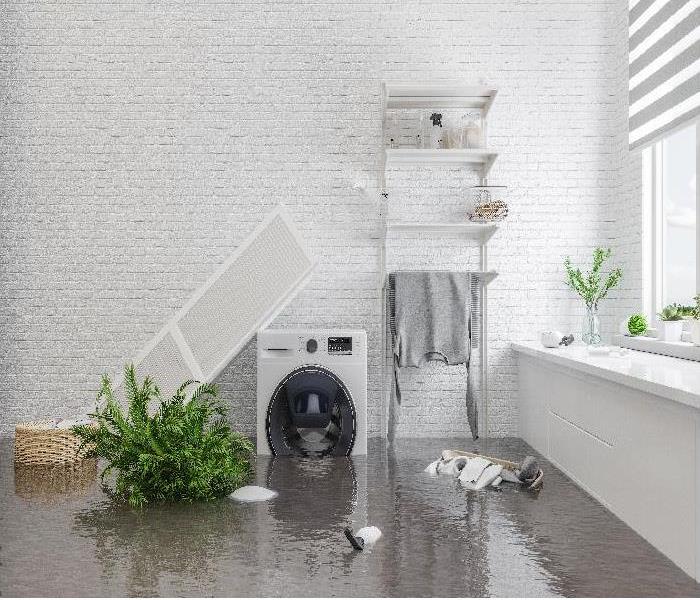 Give our SERVPRO of North Everett / Lake Stevens / Monroe team a call 24/7 at (360) 243-8313.
Give our SERVPRO of North Everett / Lake Stevens / Monroe team a call 24/7 at (360) 243-8313.
Our SERVPRO Professionals Work with Efficient Tools and Practices to Protect Your Everett Home and Its Contents from Irreparable Damage
While we might have the skilled professionals on our roster to help with full-scale reconstruction and remodeling as necessary, this is a situation that we seek to avoid as much as possible. Our SERVPRO technicians focus our efforts first and foremost on reducing the need for tear-out and reconstruction whenever possible. After flood losses, this can be a challenge.
Despite how widespread and severe flood damage in Everett homes might initially appear, we can manage these scenarios by breaking the conditions into various mitigation tasks. Each of the processes that encompass the mitigation phase involves a different approach to save customers time and money on the recovery effort their home needs. Much like every other kind of loss, the restoration of a flood involves a blend of our cutting-edge equipment and experienced professionals.
Who Does Flood Debris Removal?
Flood debris can be a substantial threat in your home, especially if contamination is a concern. Getting our team started on clearing out debris and sediment from the affected areas of your house can reduce the concentration of harmful contaminants when applicable, but also set the stage for more efficient cleaning, drying, and resurfacing. The earliest stages in the recovery of your home typically fall into three specific categories:
Muck Out
Flood debris often consists of mud, silt, and many other solids. While this might make efforts like extraction potentially challenging on their own, it also amplifies a need for muck-out debris removal. The presence of potentially contaminated mud and debris can be a hazard to those exposed, making it one of the priorities of our responding SERVPRO technicians.
Controlled Demolition
Minimizing the reconstruction that your home might need after a flood does not mean that no materials might need discarding. Choices about the conditions of exposed materials is a vital service that can showcase the portions of a structural surface damaged and requiring reinstallation. By leaving unaffected materials where they have gotten installed, we can minimize the time for reconstruction later.
Damage Assessment
Before much of the work begins in your home, our project manager and crew chief work with the customer to determine the extent of the damage in the property. Proper evaluations can help to identify problem areas quickly to make better immediate choices about controlled demolition or drying to reduce a later need for reconstruction.
When Does Extraction Begin?
Extraction is often one of the emergency services that our team provides. Standing water, especially after a flood, can be a significant hazard to the occupants of a house. From electric shock hazards to structural degradation, removing surface water can do more to protect your property and help other mitigation activities begin as soon as possible. Extraction can use any of several removal tools in our inventory but often fall into one of three primary categories.
Submersible Pumps
Electric and gas-powered submersible pumps can be vital tools in flood recovery for your house. Clean water flood scenarios can benefit from electric pumps, as they have a longer discharge line and provide a continuously quiet operation. Gas-powered trash pumps must get used when solids are present in the standing water because these units typically have an intake and discharge hose that is at least twice as large as their electric counterparts.
Wet Vacuums
Submersible pumps can only address surface water to a certain extent. Once standing water drops to two inches in depth or less, these pumps lose prime, and wet vacuums are a suitable replacement. A continual suction can remove any lingering water on the surface quickly.
Wands
Attachments for pumps and vacuums can allow for greater versatility in water removal after a flood, especially with clean water flooding that might result from roof breaches. With attachments like carpet wands or squeegee wands, we can remove surface water and much of the saturated water in hard and soft flooring materials.
Can Decontamination and Cleaning Prevent Reconstruction?
After drying has occurred following an extraction, it is necessary to look at what surfaces can get cleaned. Much of the controlled demolition choices have already gotten made at this point, so much of the decontamination and disinfection that might occur in these stages prevents further reconstruction needs.
Allowing the excessive spread and presence of bacteria, viral pathogens, or hazardous microbes can be a threat to the occupants of your home. Properly addressing these concerns is part of the restoration process and recovery effort for your property after a flood loss. Our SERVPRO professionals can utilize potent cleaning products like chlorines and antibacterial chemicals on now-exposed surfaces like wood framing or subflooring.
Flooding can be a destructive force that can often lead to a need for demolition and build back. Reducing a need for widespread replacement involves extraction, drying, and cleaning happening quickly after flooding occurs. Give our SERVPRO of North Everett / Lake Stevens / Monroe team a call 24/7 at (360) 243-8313.
For more about Everett click here.
Our Certified Experts Are Committed To Restoring Your Everett Home After A Flood
2/4/2020 (Permalink)
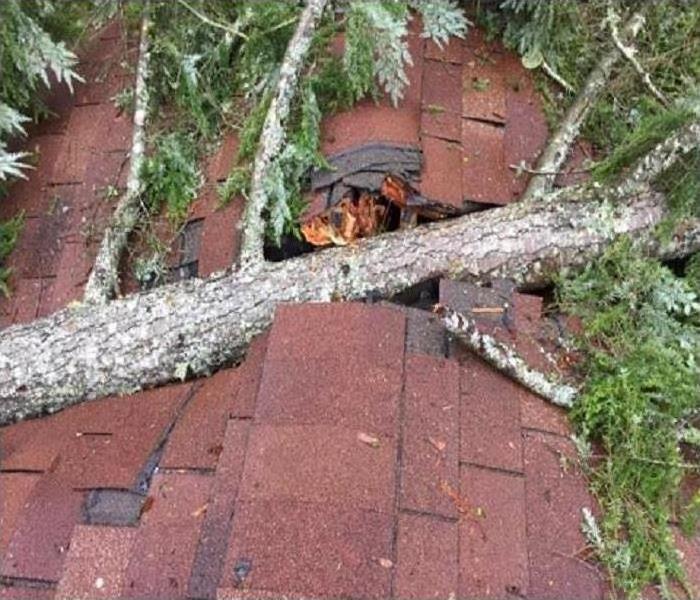 A windstorm knocked a tree over onto the roof of this home. The tree caused considerable damage to the home and we were able to restore the damage.
A windstorm knocked a tree over onto the roof of this home. The tree caused considerable damage to the home and we were able to restore the damage.
Using Axial and Centrifugal Air Movers to Speed up Drying Times after Flood Damage in Everett
Flood Damage Everett
One of the challenges facing flood recovery specialists is creating conditions for improving evaporation. Property flooding tends to go beyond a single room or area and can affect your garage, lower stories as well as exterior parts of your property. Subterranean areas of the home, such as crawlspaces or subfloor, can also become adversely affected by floodwaters. Most pumping equipment is only practical to two inches of standing water. Once standing water reduction reaches below two inches, restorers must use different methods to restore the property.
Our professional restorers can assist you with flood damage in your Everett property. Using our industry-leading training, SERVPRO technicians are experts at assessing the property and tailoring our restoration solution. One common issue we face is that not all areas of the home offer natural light and ventilation. Light and ventilation are essential to natural evaporation. Consequently, staircases and hallways can often be a challenge to dry without professional equipment.
When dealing with an area of the home that lacks natural ventilation, SERVPRO technicians rely on closed-system drying equipment. Closed-systems require equipment that is capable of heating, removing, and circulating air. When materials dry, they reduce the temperature of the air directly above them as well as saturating the air with moisture. Since cold, humid air can slow down the drying process, these layers of air directly above a wet surface can become a barrier that significantly limits the drying process. We combat this effect by using air moving equipment to remove flood damage.
Air moving equipment usually uses either centrifugal or axial impellers to move the surrounding air in a closed-system. Axial air-movers tend to be larger and suitable for removing larger bodies of air throughout a home. SERVPRO technicians can daisy-chain air-moving equipment to create a harmonious circulation of air throughout the property. Centrifugal air-movers are often more direct and are useful should a technician need to direct air to a specific area of the home such as beneath a carpet or cabinet.
Creating a strategic set up of air-movers throughout your home can significantly speed up the drying process and allow you to get back to your everyday life sooner rather than later. Contact SERVPRO of North Everett / Lake Stevens / Monroe at (360) 243-8313.
See more about Everett.
Hurricane Safety
8/6/2019 (Permalink)
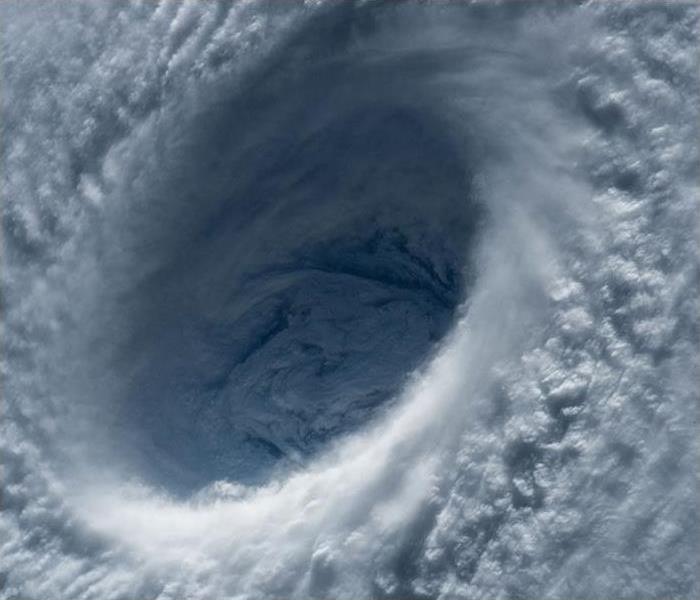 Do you know what to do if you are traveling somewhere when a hurricane hits?
Do you know what to do if you are traveling somewhere when a hurricane hits?
Here in Washington state we don't have a lot of experience with hurricanes. But it is still wise to be informed in case you are traveling in hurricane prone areas during hurricane season. Hurricane season has already begun and storms have been common the Atlantic, Carribean or Gulf of Mexico. For the Atlantic, the season begins June 1 and runs through November 30. On average, there are 12 tropical storms that develop, with an average of six becoming hurricanes, according to the National Weather Service.
Hurricanes can be life-threatening as well as cause serious property damage. The National Weather Service lists the following as potential “hurricane hazards.”
- Storm surge is the abnormal rise of water generated by a storm’s winds. This hazard is historically the leading cause of hurricane related deaths in the United States. Storm surge and large battering waves can result in large loss of life and cause massive destruction along the coast. Storm surge can travel several miles inland, especially along bays, rivers and estuaries.
- Flooding from heavy rains is the second leading cause of fatalities from landfalling tropical cyclones. Widespread torrential rains associated with these storms often cause flooding hundreds of miles inland. This flooding can persist for several days after a storm has dissipated.
- Winds from a hurricane can destroy buildings and manufactured homes. Signs, roofing material and other items left outside can become flying missiles during hurricanes.
• Tornadoes can accompany landfalling tropical cyclones. These tornadoes typically occur in rain bands well away from the center of the storm. - Dangerous waves produced by a tropical cyclone’s strong winds can pose a significant hazard to coastal residents and mariners. These waves can cause deadly rip currents, significant beach erosion and damage to structures along the coastline, even when the storm is more than a 1,000 miles offshore.
Preparation is the best protection against the dangers of a hurricane. When traveling or on vacation during hurricane season be aware of developing storms. Pay attention to weather reports and the news and have an evacuation plan in case of an emergency.
Source: noaa.gov
Summer Lightning Safety Tips
7/9/2019 (Permalink)
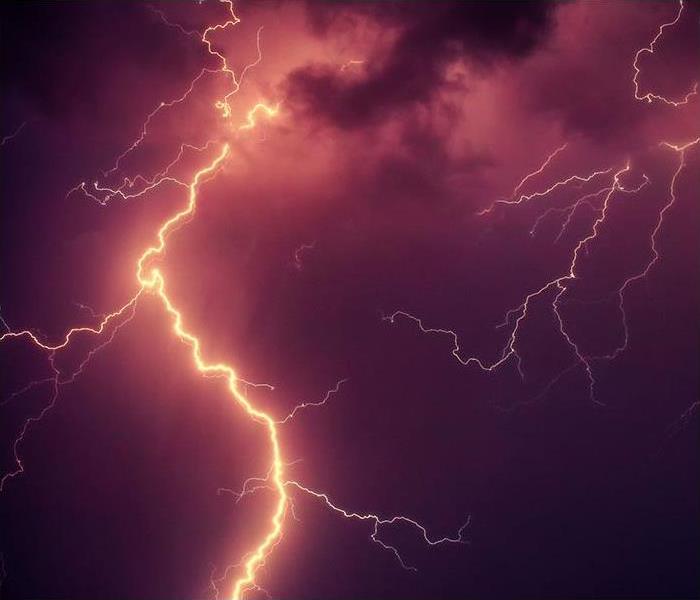 According to the National Weather Service "lightning kills an average of 47 people in the United States each year."
According to the National Weather Service "lightning kills an average of 47 people in the United States each year."
We get a lot of rain here in the Pacific Northwest, but lightning storms occur less often. When lightning does strike, do you know what to do to stay safe? Although lightning can strike anytime, the chance for lightning increases in the summer months. According to the National Weather Service "lightning kills an average of 47 people in the United States each year, and hundreds more are severely injured." Stay safe with these basic tips.
- Have a lightning safety plan so you are prepared and ready if a thunderstorm does hit.
- Cancel or postpone outdoor activities if thunderstorms are expected.
- If you do get caught outside, avoid high ground, open spaces, and all metal objects including electric wires, fences, etc. Seek shelter in a substantial building or a fully enclosed metal vehicle.
- If you are indoors, stay away from doors and windows. Do not use the telephone. Consider unplugging computers, power tools, & TV sets. Lightning may strike exterior electric/phone lines, inducing shocks to inside equipment.
Most lightning-related deaths occur when people are having fun outside. If you hear thunder or see lightning, immediately seek shelter in an enclosed building or vehicle. Remember, When Thunder Roars, Go Indoors! weather.gov/lightning
Source: the National Weather Service
Preparing for Extreme Summer Heat
5/18/2019 (Permalink)
 Are you prepared for extreme summer heat?
Are you prepared for extreme summer heat?
As summer approaches, it is time to consider safety precautions for potential extreme heat in the coming months. Heat affects all people, but especially the young, elderly, sick, and overweight. Urban area residents also have a greater chance of being affected than those who live in rural areas due to the heat island effect.
According to the EPA, “the sun can heat dry, exposed urban surfaces, such as roofs and pavement, to temperatures 50–90°F hotter than the air, while shaded or moist surfaces—often in more rural surroundings—remain close to air temperatures.” These surface heat islands are strongest during the day when the sun is shining, while the atmospheric heat islands are more likely after sunset “due to the slow release of heat from urban infrastructure.”
Whether you are in an urban or rural area, there are several things you can do to prepare for and prevent extreme heat from affecting you. If possible, stay indoors in air conditioning. Be sure to check on your pets who may be outdoors or bring them inside. Stay hydrated and limit alcohol and caffeine intake.
If you must go outside, wear loose-fitting, light-colored clothing, and be sure to apply sunscreen often. Pay attention to signs of heat exhaustion, which are heavy sweating; weakness; cold, pale, and clammy skin; nausea or vomiting; and fainting, according to the Center for Disease Control and Prevention (CDC). Heat exhaustion can lead to heat stroke, which is life-threatening. Signs of heat stroke are a high body temperature (103°+), rapid and strong pulse, and possible unconsciousness. If you think someone has heat stroke, call 911 immediately and move the person somewhere cool. Reduce body temperature with cool, wet cloths or a bath. Do not give a person with heat stroke fluids, and treat the situation as a serious medical emergency (CDC).
In order to prepare your home for extreme heat, follow these safety tips:
- Install window air conditioners snugly; insulate if necessary.
- Check air-conditioning ducts for proper insulation.
- Install temporary window reflectors (for use between windows and drapes), such as aluminum foil-covered cardboard, to reflect heat back outside.
- Weather-strip doors and sills to keep cool air in.
- Cover windows that receive morning or afternoon sun with drapes, shades, awnings, or louvers. (Outdoor awnings or louvers can reduce the heat that enters a home by up to 80 percent.)
- Keep storm windows up all year.
When it is humid, be aware of the heat index. The heat index factors in the humidity, which can make the temperature feel 15° hotter.
Extreme heat is a serious danger. For more information on preparation and prevention, visit ready.gov or cdc.gov.
Source: ready.gov
Generator Safety
4/6/2019 (Permalink)
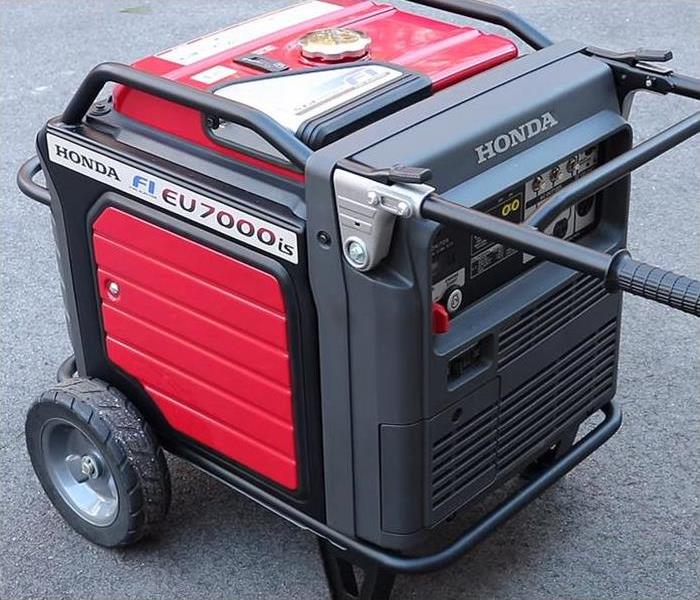 Do you know how to safely use your generator this winter?
Do you know how to safely use your generator this winter?
If you have a generator on hand for power outages during severe weather, follow the safety tips below from the American Red Cross:
- Never use a generator, grill, camp stove, or other gasoline, propane, natural gas, or charcoal-burning devices inside a home, garage, basement, crawl space, or any partially enclosed area.
- To avoid electrocution, keep the generator dry and do not use in rain or wet conditions. Operate it on a dry surface under an open canopy-like structure, such as under a tarp held up on poles. Do not touch the generator with wet hands.
- Opening doors and windows or using fans will not prevent carbon monoxide (CO) buildup in the home. Although CO can’t be seen or smelled, it can rapidly lead to full incapacitation and death. Even if you cannot smell exhaust fumes, you may still be exposed to CO. If you start to feel sick, dizzy, or weak while using a generator, get to fresh air immediately. Install CO alarms in central locations on every level of your home or property and outside sleeping areas to provide early warning of accumulating carbon monoxide.
Be sure to use caution when using generators. And if your home receives damage from fire or storm, give SERVPRO of North Everett/Lake Stevens/Monroe a call at 360-243-8313.
If Disaster Strikes, Will You Be Ready?
3/2/2019 (Permalink)
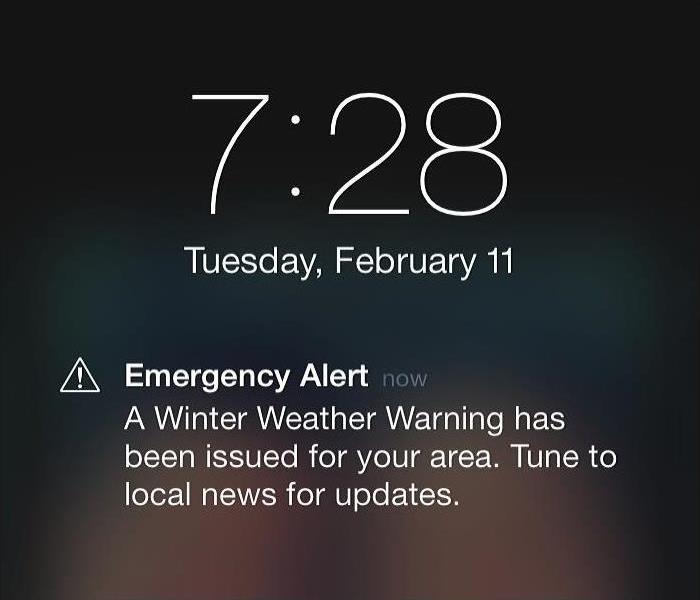 Wireless Emergency Alerts are designed to inform you of imminent threats to safety or missing persons alerts in your area.
Wireless Emergency Alerts are designed to inform you of imminent threats to safety or missing persons alerts in your area.
It is important to prepare before a disaster occurs. Consider the following steps to help you better prepare for an emergency situation.
- Sign up for local alerts and warnings, download apps and/or check access for wireless emergency alerts (see below for suggestions).
- Develop and test emergency communication plans.
- Assemble or update emergency supplies.
- Learn about local hazards and conduct a drill to practice emergency response actions.
- Participate in a preparedness discussion, training or class.
- Collect and safeguard critical documents.
- Plan with neighbors to help each other and share resources.
- Document property and obtain appropriate insurance for relevant hazards.
- Make property improvements to reduce potential injury and property damage.
Wireless Emergency Alerts
Wireless Emergency Alerts (WEAs) are free notifications delivered to your mobile device as part of a public safety system provided by authorized government-alerting authorities. The alerts are designed to inform you of imminent threats to safety or missing persons alerts in your area (e.g., AMBER Alerts). Government partners include local and state public safety agencies, FEMA, the FCC, the Department of Homeland Security, and the National Weather Service. A WEA can be sent to your mobile device when you may be in harm’s way, without downloading an app or subscribing to a service. WEAs may be used to share extreme weather warnings, local emergencies requiring evacuation or immediate action, AMBER Alerts, and Presidential Alerts during a national emergency.
A WEA will look like a text message. The WEA message will typically show the type and time of the alert, any action you should take, and the agency issuing the alert. The message will be no more than 90 characters.
The FEMA App
This app allows you to get National Weather Service alerts for up to five locations to keep you informed on-the-go. It also has information on what to do before, during, and after different disasters. In the midst of an emergency, the app can give you directions to open shelters nearby, help you locate someone to talk to at a Disaster Recovery Center, and let you share images of damage and recovery efforts to help first responders and emergency managers.
This app is available to download for free for iOS and Android at the Apple Store and on Google Play.
Emergencies can happen anytime to anyone. Make sure to take action now to protect yourself, your family and your property. If disaster does strike your property, make sure to give SERVPRO of North Everett/Lake Stevens/Monroe a call at 360-243-8313. We can help make the damage "Like it never even happened."
Are You Ready for Winter Weather?
10/31/2018 (Permalink)
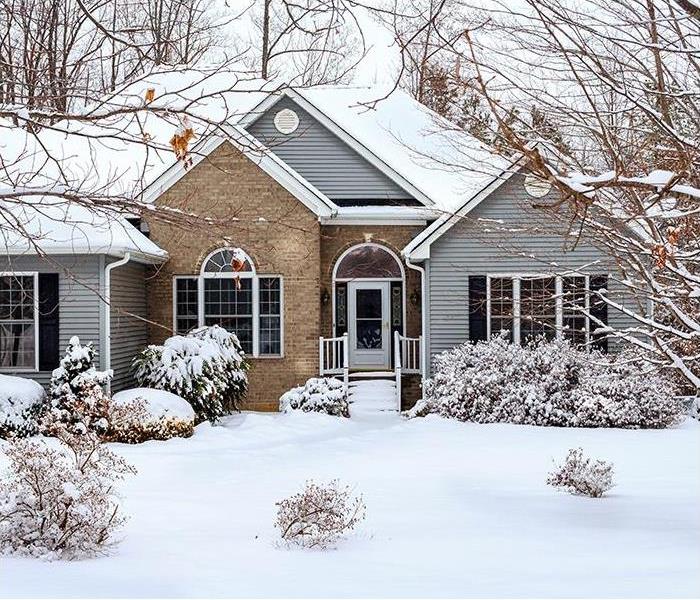 While you cannot control the weather, you can prepare for colder winter weather.
While you cannot control the weather, you can prepare for colder winter weather.
Are you prepared for the coming cold weather? Cold weather can have a huge impact on your home or business if you are not ready for it. From heavy rain and freezing temperatures to damaging winds, sleet, or snow, all can cause serious and costly property damage. While you cannot control the weather, you can take steps to be prepared and help take the sting out of winter weather.
To help prevent costly damages due to weather, consider taking the following precautions to protect your property before colder weather hits.
- Check your property for downed tree limbs and branches. Wind, heavy rain, ice, and snow can cause branches to fall, which could cause damage to the property and potentially cause personal injuries.
- Roofs, water pipes, and gutters should all be inspected to ensure they are in proper order. Gutter downspouts should be directed away from your building. Clear gutters of debris that may have gathered during the fall. Leaves and other obstructions can cause a damming effect, which can lead to roof damage and interior water problems.
- Inspect property, especially walkways and parking lots, for proper drainage to alleviate flood hazard potential.
- Inspect all handrails, stairwells, and entryways to address and correct potential slippery or hazardous areas. Install mats or non-slip surfaces and post caution signs where water could be present.
- Protect water pipes from freezing by simply allowing water to drip when temperatures dip below freezing. If pipes are under a cabinet, leave the cabinet doors open, allowing warm inside air to circulate around the pipes. If the building has outdoor faucets, consider shutting water off at the main valve in the basement or crawl space. Once the valve is off, open the outdoor faucet to ensure it drains, preventing any remaining water from freezing in the pipe.
- Ask us about completing an Emergency READY Profile (ERP) for your business. The ERP is a no-cost assessment to your facility and provides you with a plan to get back to business fast following a disaster.
When winter weather strikes, call SERVPRO of North Everett/ Lake Stevens/ Monroe to strike back. With our 24/7 emergency service, we’re there when you need us most. Call us at 360-243-8313.
Leave the Hassle of Board-Ups to the Professionals
8/6/2018 (Permalink)
 SERVPRO of North Everett/ Lake Stevens/ Monroe can take care of boarding up your property.
SERVPRO of North Everett/ Lake Stevens/ Monroe can take care of boarding up your property.
Whether after a fire, storm, or other structural disaster, boarding up damaged property is a burden that no one should ever have to go through— especially if it's your property that has been damaged.
Boarding up damaged property incorrectly could cause secondary damages such as moisture or animal intrusion, making the situation even worse. The process of boarding up after an unexpected damage can also be as dangerous as the damage itself.
SERVPRO of North Everett/ Lake Stevens/ Monroe can board up your damaged property and mitigate and remediate the original damage, providing you with peace of mind while helping make it “Like it never even happened.”
We have the skills and knowledge to board up broken windows, damaged roofs, burned drywall or any other damaged entrance to your property. Whether the damage is from fire, flooding, or debris during windstorms, we have the experience to board up your home and secure it from further damage. And we are available 24/7, so we can get there before the damage gets even worse.
If your property is in need of any board-up services, give SERVPRO of North Everett/ Lake Stevens/ Monroe a call at 360-243-8313.
Be Ready for Whatever Happens
7/9/2018 (Permalink)
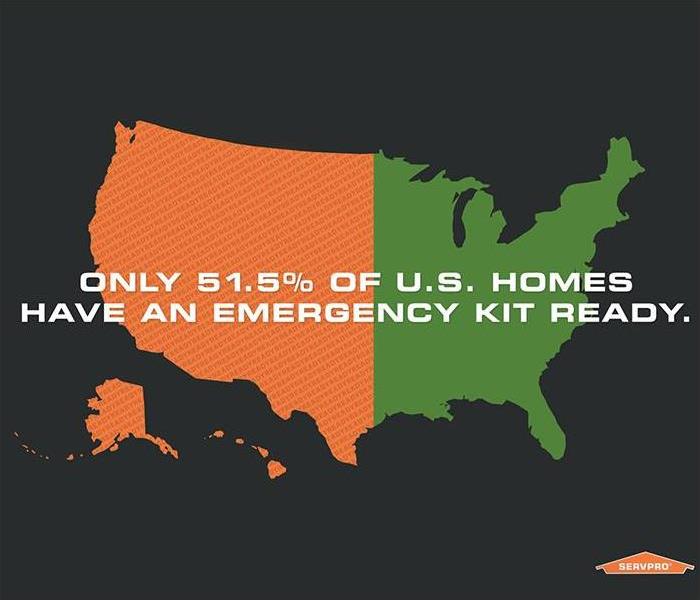 Are you ready for emergencies? Make sure you have an emergency kit for you and your family.
Are you ready for emergencies? Make sure you have an emergency kit for you and your family.
National Preparedness Month is just around the corner and it’s a great time to make sure you and your family is prepared for potential disasters. National Preparedness Month, which takes place in September, strives to increase the overall number of individuals, families, and communities that engage in preparedness actions at home and work.
Join in the effort to get your home ready for potential disasters. Only 51.5% of U.S. homes have an emergency kit ready. By creating an Emergency Kit you can be “Ready for whatever happens.”
Ready.gov suggests you have enough supplies to last for at least three days. Below is a quick list of suggested items to include in your kit:
- 3-day supply of nonperishable foods
- Water (one+ gallon per person per day)
- First-aid kit
- Prescription medication
- Sleeping bag or blankets
- Fire extinguisher
- Hygiene products
- Flashlights
- Extra batteries
- Cell phone charger
- Change of clothes
- Matches in waterproof container
- Wrench or pliers to turn off utilities
- Whistle to signal for help
- Pet supplies
- Infant formula and diapers
- Important documents such as insurance policies, IDs, and bank records in a plastic container
Also, keeping a small emergency kit in your vehicle can be useful during an emergency. For more detailed instructions on creating an emergency kit check out our other blog post here and check out Ready.gov for a more extensive list.
Tsunamis and How to Prepare
5/18/2018 (Permalink)
 Tsunamis are most likely to hit the Pacific coastline or in the Caribbean, so it is good to know what to do if one occurs.
Tsunamis are most likely to hit the Pacific coastline or in the Caribbean, so it is good to know what to do if one occurs.
Did you know tsunamis could hit any U.S. coast? Though the risk for tsunamis is low, they are more likely to hit states on the Pacific coastline or in the Caribbean, so it is good to know what to do if a tsunami does strike here, or where you may vacation.
Ready.gov says, “Tsunamis, also known as seismic sea waves (mistakenly called “tidal waves”), are a series of enormous waves created by an underwater disturbance such as an earthquake, landslide, volcanic eruption, or meteorite.” Areas within a mile of the coast and less than 25 feet above sea level have a greater risk of being hit.
As with any emergency, be sure you have a plan. Create a 72-hour kit ahead of time so you can be ready to leave quickly. Know the evacuation plan and move inland or to higher ground and avoid the beach. “The first wave may not be the last or the largest,” according to the National Weather Service.
After a tsunami, do not return to the affected area until officials deem it safe. While drowning is the most common hazard, there are many aftereffects such as flooding and contaminated drinking water.
For more information on preparing for a tsunami, visit ready.gov/tsunamis.
Flooding Can Happen Anywhere
4/6/2018 (Permalink)
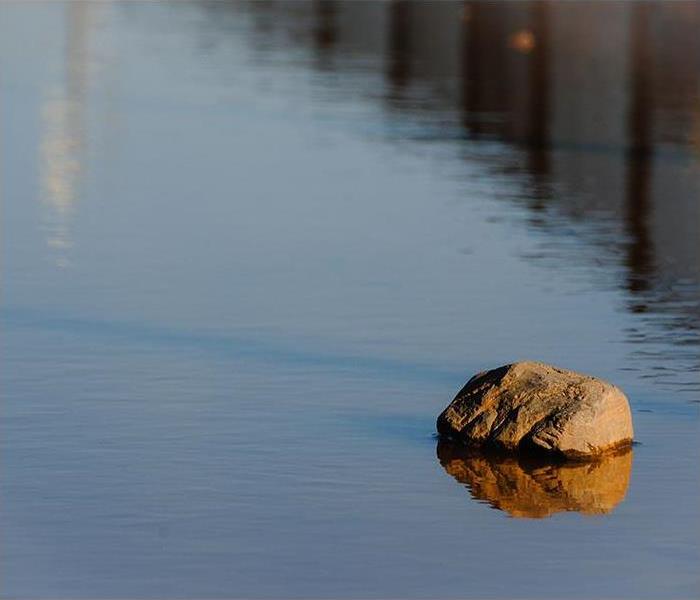 Just because your property hasn’t experienced a flood in the past does not mean it won’t in the future.
Just because your property hasn’t experienced a flood in the past does not mean it won’t in the future.
Floods are one of the most common and widespread natural disasters in the United States. And we’ve had our fair share here in Snohomish County. Whether your home or business is near the coastline, along city streets, in the mountains or near a river—there is always potential for flood damage. Fema.gov reports, in the last 5 years, all 50 states have experienced floods or flash floods.
According to the National Weather Service (NOAA), “Approximately seventy-five percent of all Presidential disaster declarations are associated with flooding.” NOAA lists the most common flood hazards in the United States as:
- Flash Flooding
- River Flooding
- Storm Surge and Coastal Inundation from Tropical and Non-Tropical Systems
- Burn Scars/Debris Flows (Caused by Wildfires)
- Ice/Debris Jams
- Snowmelt
- Dry Wash (Caused by heavy rainfall in dry areas)
- Dam Breaks/Levee Failure
Just because your property hasn’t experienced a flood in the past does not mean it won’t in the future. In fact, nearly 20% of all flood insurance claims come from moderate-to-low risk areas, and even just one inch of flood damage in an average home can cost you up to $27,000*. On average, floods cost $3.5 billion in annual losses in the U.S., and commercial flood claims average more than $75,000 (NFIP).
According to the American Red Cross, floods cause more damage in the U.S. every year than any other weather related disaster. The American Red Cross offers the following flood safety tips.
- Stay away from floodwaters. If you come up on a flowing stream where water is above your ankles, stop, turn around, and go another way. Six inches of swiftly moving water can sweep you off of your feet.
- If you approach a flooded road while driving, turn around and go another way. If you are caught on a flooded road and waters are rising rapidly around you, get out of the car quickly and move to higher ground. Most cars can be swept away by less than two feet of moving water.
- Keep children out of the water. They are curious and often lack judgment about running water or contaminated water.
For more flood safety tips check out this great article from The Everett Herald. Also, take a look at Snohomish Country’s Real-Time Flood Information System to see what the current river level and rainfall depth data is in our area.
When catastrophic water damage happens to you, SERVPRO of North Everett/ Lake Stevens/ Monroe can help. We can help you prepare ahead of time with an Emergency Ready Profile (ERP), or respond to any size disaster to begin cleanup and restoration to get your property back to normal as soon as possible.
At SERVPRO of North Everett/ Lake Stevens/ Monroe we are ready to help make it “Like it never even happened.” Give us a call at 360-243-8313.
*Facts and figures provided by fema.gov and the National Weather Service (NOAA)
When Disaster Strikes, SERVPRO’s Disaster Recovery Team is Here to Help
3/2/2018 (Permalink)
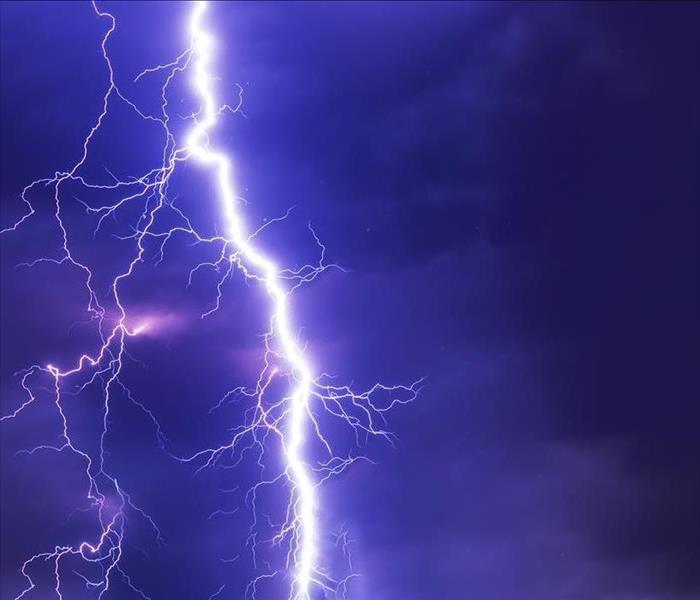 As a member of SERVPRO’s Disaster Recovery Team, SERVPRO of North Everett/ Lake Stevens/ Monroe is “Ready for whatever happens.”
As a member of SERVPRO’s Disaster Recovery Team, SERVPRO of North Everett/ Lake Stevens/ Monroe is “Ready for whatever happens.”
Severe weather can happen any time, anywhere. Each year, Americans experience an average of*:
- 10,000 severe thunderstorms
- 5,000 floods or flash floods
- 1,300 tornadoes
- 2 land-falling deadly hurricanes
As a member of SERVPRO’s Disaster Recovery Team, SERVPRO of North Everett/ Lake Stevens/ Monroe is “Ready for whatever happens.” When a storm or disaster strikes, SERVPRO’s Disaster Recovery Team is poised for any storm that may happen. With a network of more than 1,700 Franchises, the SERVPRO System strives to be faster to any size disaster. Strategically located throughout the United States, SERVPRO’s Disaster Recovery Team is trained and equipped to handle the largest storms and highest flood waters. Providing experience, manpower, equipment, and other resources, the Disaster Recovery Team is there when large storms hit our area. SERVPRO’s Disaster Recovery Team has responded to hundreds of disaster events. In the aftermath of a disaster, there is only one objective: to help you make it “Like it never even happened.”
With the ability to mobilize local command centers, along with the resources of more than 1,700 Franchises nationwide, no disaster is too big. Recent mobilizations of the Catastrophic Storm Response Teams included:
- 2017 Hurricane Harvey
- 2016 East Tennessee Wildfires
- 2016 Hurricane Matthew
- 2016 Louisiana Flooding
- 2016 Houston, TX Flooding
- 2015 Siberian Express
- 2014 Mid-Atlantic Flooding
- 2014 Polar Vortex
- 2013 Colorado Floods
- 2012 Hurricane Sandy
No matter the size of the disaster, SERVPRO of North Everett/ Lake Stevens/ Monroe is Here to Help. With the help of SERVPRO’s Disaster Recovery Team, we can handle any size weather event. If disaster strikes your home or business, give us a call at 360-243-8313.
*Facts and figures provided by noaa.gov
5 Ways to Prepare Your Home for Windstorms
11/30/2017 (Permalink)
 There’s not always a lot of warning before a large windstorm hits, so it’s important to prepare your home well beforehand.
There’s not always a lot of warning before a large windstorm hits, so it’s important to prepare your home well beforehand.
Windstorms cause millions of dollars of damage across the Pacific Northwest every year. There’s not always a lot of warning before a large windstorm hits, so it’s important to prepare your home well beforehand. Small fixes now can prevent more costly repairs after a storm.
Trim Your Trees
Check your property for any tree branches that hang over your roof, cars, power lines, or shed. Overhanging branches can cause significant damage to your property if they fall, which you can easily prevent by cutting them down before a storm hits.
If you have dead trees or branches on your property, get them professionally removed.
Inspect the Roof and Garage
Any loose roofing material will be particularly susceptible during a windstorm. Further damage can occur when a windstorm rips loose material off the roof. Before the windstorm hits, check your roof for loose shingles, flashing, gutters, edging strips, etc. Make sure any problems you find are fixed ASAP.
Your garage door, if it is not in top shape, can be a liability as well. If you haven’t had it professionally inspected in a while, consider doing so.
Protect Your Windows
Strong winds and flying debris can damage windows, so make sure they are prepared before the storm comes in. If you don’t have stormproof windows installed, you can use aluminum or steel shutters or plywood to protect your windows from damage.
Secure Items Around Your Property
While wind can cause a lot of damage on its own, loose items around the yard can severely increase the damage potential. If you received a report of an impending windstorm, secure or safely store items like:
- Grills
- Patio Furniture
- ATVs
- Garbage and recycling bins
- Container plants
- Wind chimes and other decor
- Trampolines
- Swing sets and toys
- Bicycles
Make sure to store cleaning chemicals, motor fuels, and pesticides in safe places as well. You don’t want chemicals to mix together or spread throughout your yard or home
Put Together an Emergency Kit
If the windstorm takes out the power, in some cases you may have to go without electricity for a few days until it gets fixed. Prepare emergency kits with food, water, and anything else your family might need to get through three days without power.
Even the most prepared home can sustain damage during a bad windstorm. Fortunately, at SERVPRO® of North Everett/ Lake Stevens/ Monroe, we’re prepared to restore your home “Like it never even happened.”
We offer a wide range of services (like board-ups, water damage restoration, tree removal, tarp-ups, and other roofing services) to help repair your property after a storm. We’re there when you need us with our 24/7 emergency service, so give us a call at 360-243-8313.
Be Prepared: Gear Up with a 72-Hour Emergency Kit
7/11/2017 (Permalink)
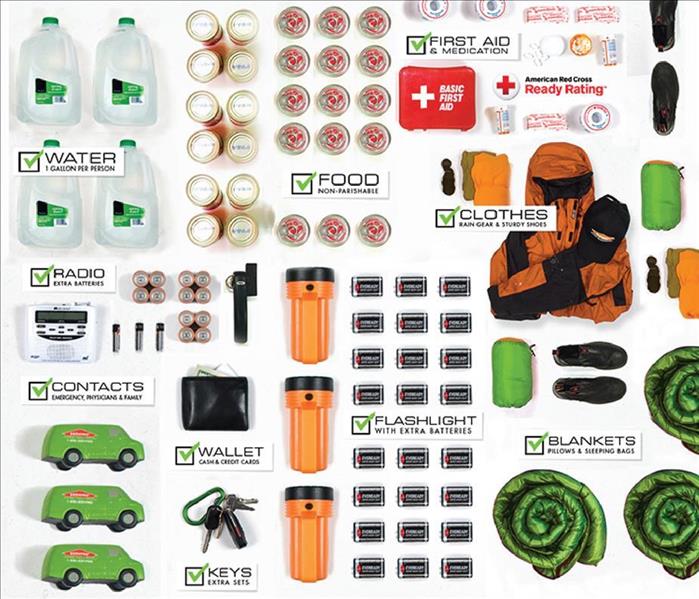 If disaster occurs, it is important to be able to take care of yourself and your family. Be prepared to meet your family’s needs for at least 3 days.
If disaster occurs, it is important to be able to take care of yourself and your family. Be prepared to meet your family’s needs for at least 3 days.
Unfortunately, storms and natural disasters don’t wait until we’re ready before they strike—they’re on their own timetable. Earthquakes, windstorms, and floods, if severe enough, can even prevent emergency services from reaching all affected areas for days. Until they arrive, you’ll need to be able to take care of yourself. Don’t delay preparing an emergency preparedness kit for your family.
Picking a Pack
You should be prepared to meet your family’s needs for at least three days. Prepare a 72-hour emergency kit for each member of your family.
If a storm or other disaster is destructive enough, you may have to leave your home. These kits should be packed in something portable, like a suitcase or backpack. Back-to-school sales are a perfect opportunity to buy backpacks for your kits.
Make sure to store your kits somewhere easily accessible in an emergency, like a coat closet near the front door.
Food & Water
The first rule of food in an emergency kit is packing nonperishable items your family will actually eat. Here are a few ideas to get you started:
- Crackers
- Trail mix
- Granola Bars
- Jerky
- Canned vegetables and fruit
- Canned stews and other meals
- Candy
- Tuna
- Baby formula (in at least two kits in case your family gets separated) if needed
- Pet food and supplies if needed
Remember—you must be able to open your food. If you pack cans, make sure you have a can opener. Scissors are great for opening plastic packaging. It’s a good idea to bring along a set of dishes as well.
Plan for about a gallon of water per person per day. Water bottles are an easy way to store and carry water. You can also consider buying portable water filtration systems. Filtration systems should not be considered a substitution for bottled water because you can’t depend on water, contaminated or not, being available everywhere.
Take note of expiration dates. As a general rule, check your emergency food storage every six months. A good trick is to check your storage when daylight savings begins and ends. You should check on your water every 6-12 months.
Medicine & Hygiene
All 72-hour kits should include a first aid kit. You can either buy one or put one together yourself. You can start to build a first aid kit with the following items:
- Various sizes of bandages and gauze
- Antibiotic and hydrocortisone ointments
- Antiseptic wipes
- Oral thermometers
- Antacid
- Scissors and tweezers
- Gloves
- Aspirin
- Cold compress
- Matches in a waterproof container
Don’t forget to include your personal medication as well along with children’s versions of medication if necessary. If your medication needs to be refrigerated, buy an insulated container to carry in your kit. Make sure you rotate medication according to expiration dates.
You’ll also want to pack hygienic and personal items. This will vary family to family. You can start with items on this list, if applicable:
- Toothpaste, toothbrushes, and floss
- Feminine hygiene products
- Glasses, contacts, contact cases and solution
- Baby wipes and diapers
- Soap bars
- Toilet paper
Clothing & Comfort
While it’s possible to wear the same clothes for three days, your family will be a lot more comfortable if they have a fresh pair of clothes to change into each day. If your clothing gets wet, it can even be a safety hazard if it’s cold out.
Along with clothes, bring along a sleeping bag or blanket (foil blankets can easily fit in these packs and sleeping bags can attach to bags with straps).
Tools & Electronics
A small tool kit can be very useful in an emergency. At least in adult kits, include a wrench, screwdriver, and Swiss Army knife.
Make sure every member of the family has a flashlight (with extra batteries), along with a battery or crank-powered radio. Include extra cell phone chargers in your packs as well, in case you end up somewhere with electricity.
Personal Documents & Cash
In an emergency, you may not have the chance to gather your personal items. Keep copies of important documents in your emergency kit. Include items such as:
- Birth and marriage certificates
- Social security cards
- Drivers Licenses or State IDs
- Pictures of your family members
You’ll also want to have cash in each kit because credit/debit cards may not work if electricity is out. It’s important to carry both bills and coins. Add money to your kits weekly to build up your reserve.
Personal Entertainment
Three days is a long time without any kind of entertainment, especially if you are used to using electronics. Pack a few items to help the time pass for both you and any children. Some ideas include:
- Coloring and activity books
- Small puzzles
- Books to read
- Decks of cards
Anything small and easily portable that doesn’t require electricity will do.
If a disaster hits your home, it’s important to be prepared to act quickly. Preparing now can help keep you and your family safe in the future.
If your home sustains damage from a storm or natural disaster, we can help restore it “Like it never even happened.” Call SERVPRO® of North Everett/ Lake Stevens/ Monroe at 360-243-8313 for 24-hour service.
Don’t Be Afraid of the Dark: How to Prepare for Power Outages
7/11/2017 (Permalink)
 Be prepared for when the power goes out so you don't have to be afraid of the dark.
Be prepared for when the power goes out so you don't have to be afraid of the dark.
Power outages can range from mildly inconvenient to a crisis depending on the severity of the cause and the amount of time an area goes without power. However, when it comes to preparation, you are anything but powerless.
Keep Alternative Sources of Light
Invest in flashlights for every major room in the house, and keep them in accessible areas such as:
- Nightstands
- Kitchen drawers
- Bathroom cabinets
- Entertainment centers
Make sure you have the appropriate back-up batteries for each flashlight. For rooms where you’ll want to be more hands-free, like the bathroom, choose flashlights with a hook.
If you choose to use candles, keep a supply of matches in a cool, dry place. Place candles away from flammable materials like curtains and furniture. Keep all candles and matches out of reach of young children and pets.
Protect Your Electronics
After a power outage is fixed, your home may experience a surge of electricity, which can harm your electrical appliances. If the power goes out, unplug all your valuable electronics—especially TVs, laptops, phones, microwaves, etc.
Check your devices and outlets for scorch marks before turning them on after a power outage.
Store Food and Water
You’ll need at least two quarts of water stored for each person every day. However, it’s better to have a gallon. Remember to rotate your water storage as needed.
Include a couple of buckets in your emergency supply. You can fill your bathtubs full of water from the tap immediately as the power goes out and use buckets to flush toilets, depending on your type of pump, without using your drinking water supply.
Maintain a supply of non-perishable foods that don’t require a lot of cooking. Try to have at least a three-to-five-day supply of food your family will actually want to eat. Make sure you have manual can and bottle openers.
Avoid eating any potentially spoiled food. Your refrigerator, if full, should stay cool for around 24 hours if you keep it closed. A full freezer may last up to 48 hours.
Keep your pets in mind while gathering supplies. Make sure you have food and water for them as well.
Prepare First Aid Kits and Medicine
If you have any medications you need to keep cool, invest in an ice cooler. Make sure you have ice on hand to keep it cold. You can use coolers to keep some of your perishable food cold as well.
Either buy or put together first aid kits. The Red Cross provides a good guide on what to include. Don’t forget any medications specific to your family’s needs.
Charge Your Communication Devices
Your cell phone can be your connection to valuable information during an outage, but it’s useless if it runs out of battery. Invest in a car charger as well as a solar or crank-powered charger. You won’t regret having a few options.
You may also want to invest in a battery-, solar-, or crank-powered radio in case you don’t have cell service during an emergency. Don’t forget to keep extra batteries around.
Follow Snohomish County Public Utility District (PUD) for up-to-date information on power outages. Their website provides information on how to report power outages as well as more tips for what to do to stay safe. Keep a list of utility numbers to contact during an emergency.
Power outages can be stressful, but proper preparation can help keep you safer and more comfortable. If your home or property is damaged during a storm or outage, call SERVPRO® of North Everett/ Lake Stevens/ Monroe to make your home “Like it never even happened.”
With our 24/7 emergency service, we’re there when you need us most. Call us at 360-243-8313.
What to Do If a Tree Falls on Your House
5/26/2017 (Permalink)
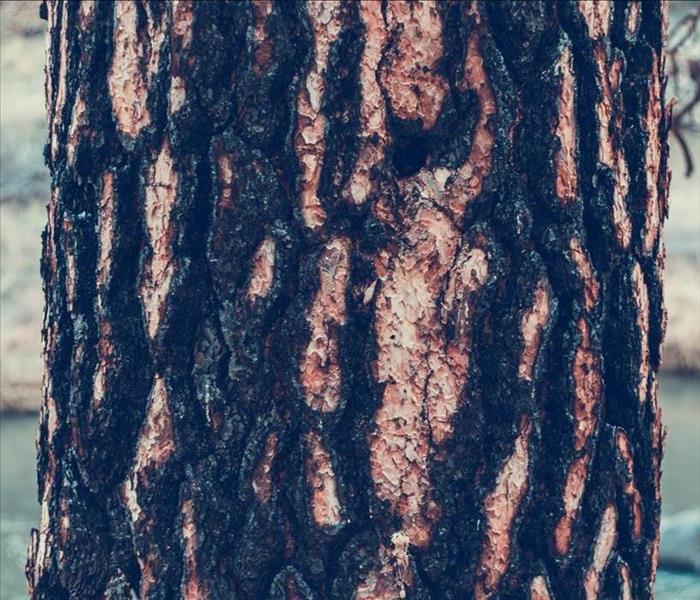 If a tree falls on your home, don’t hesitate to give us a call any time, day or night—we offer 24/7 services.
If a tree falls on your home, don’t hesitate to give us a call any time, day or night—we offer 24/7 services.
Many things can cause a tree to fall on your home—windstorms, tree decay, soil erosion, rain, and more. Unfortunately, fallen trees can cause a lot of damage and lead to dangerous situations. It’s important to act quickly in order to be safe and prevent as much damage as possible.
Preventative Care
Powerful storms can blow down even well-rooted trees; however, there are steps you can take to help prevent trees and branches from falling on your house during a storm.
- Watch for and remove dead branches/trees
- Keep an eye out for tree diseases and decay
- Prune stray or weak branches properly
- Strengthen forked trunks with cables or braces
- Look out for leaning trees
- Examine trees for cracks
- Check out the roots for signs of fungi or decay
Evacuate the House
Until a professional can fully assess the situation, it’s important to leave the home. The tree could have fallen on a powerline, damaged wiring with the house, or caused structural damage to your home. Even if you don’t suspect the damage was too significant, it’s better to be safe than sorry.
Do not attempt to remove fallen branches or trees from your property—especially during a storm. You could easily slip and fall off your roof, get blown off by a strong gust of wind, or even get hit by lightning.
Check Your Property for Electrocution Risks
When you leave the house, take a look at your property. Examine the fallen tree from a safe distance. Did it take a powerline down with it? Are there trees that have fallen against powerline poles? Have any powerlines fallen on your property? If the answer to any of these questions is yes—call 911.
Do not approach any fallen trees, poles, or wires.
Call SERVPRO® of North Everett/ Lake Stevens/ Monroe
Once you’re safely out of the house, and (if necessary) have called 911, give us a call.
Safety and weather permitting, we’ll get the tree removed, assess the damage, and tarp up the roof to prevent further damage. If the storm is still going on, we’ll patch up the problem as much as we can and more fully assess the damage as soon as it is safe for our technicians to do so.
We offer a variety of services including water extraction and drying, small construction, window board up, and more. We work with homeowners to determine precisely what you want done. If you’d like, we’ll even call your insurance company on your behalf.
If a tree falls on your home, don’t hesitate to give us a call any time day or night—we offer 24/7 services. At SERVPRO® of North Everett/ Lake Stevens/ Monroe we can make your home “Like it never even happened.” Call us at 360-243-8313.
Understanding Weather and Flood Reports
4/14/2017 (Permalink)
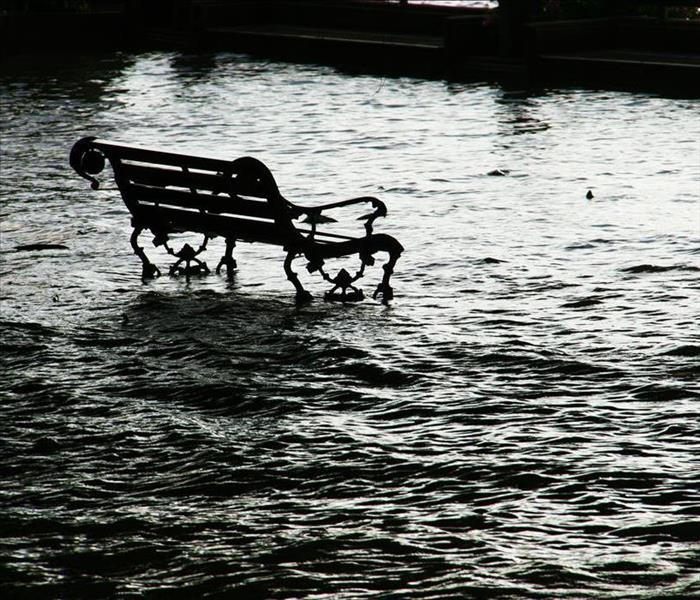 Learn how to understand weather and flood warnings so you can be prepared before storms hit.
Learn how to understand weather and flood warnings so you can be prepared before storms hit.
How many times have you watched the weather and expected a huge storm and ended up with a slight drizzle? Have you ever wondered when you should be worried about flooding in your area? Weather reports can be confusing if you don’t understand the terms used to describe storms and floods.
Learning the Weather Lingo
Meteorologists use different terms to represent the severity and imminence of a weather event. Once you crack the code, it’s easy to know generally what to expect. These terms are used to describe the status of anything from a wind storm to a blizzard.
- Advisory: Advisories mean a weather condition is expected, but it’s often used for less severe kinds of weather. Advisories often indicate a weather condition that will happen within the next 24 hours or so. Meteorologists might refer to a wind advisory for relatively low-magnitude winds. Extreme winds, because of their potential for danger, would be indicated with a warning, not an advisory.
- Outlook: Outlooks mean that a hazardous weather condition is possible in a few days. This is often your first notice that the potential for bad weather is on the horizon. You may hear a meteorologist refer to a weekend storm outlook.
- Watch: Watches mean that a hazardous weather condition is possible or likely. This term is often used for weather conditions that could happen over the next few days across a large area. You might hear terms like “winter storm watch” while watching the news.
- Warning: Warnings mean a hazardous weather condition is expected to happen or is already happening. This term is used for imminent weather conditions. Warnings are used for weather events that will likely be significant enough to cause damage to property or physical harm. Meteorologists might issue a heavy snow warning to indicate significant and imminent snowfall.
The terms watch and warning also apply to floods. If you hear about a flood watch, conditions are such that a flood could be possible, and you can start planning and paying more attention to weather reports. If you hear about a flood warning, a flood is either imminent or already occurring; you’ll want to watch for details about what areas the flood will likely impact and make the necessary preparations.
If you have questions about terms used for specific weather conditions, the National Weather Service provides a comprehensive glossary online.
Understanding Flood Phases
A large storm or consistent, heavy rain can cause a flood at any point in the year, but the winter months, November through February, bear the greatest flood risk.
Snohomish County breaks down floods into four phases, which each indicate a rising level of risk.
- Phase 1: Phase 1 warnings are brought to the county staff’s attention. Although actual flooding is rare at this level, the county will prepare to open the Emergency Operations Center if necessary.
- Phase 2: In Phase 2 and above, the Emergency Operations Center opens, and warnings will go out to emergency personnel such as the police and fire department. The news and schools will be alerted as well. The area may experience minor flooding with some road closures. Staff will monitor and report river gauge/level information hourly.
- Phase 3: Levees, also known as dikes, are at risk of breaches/overtopping at Phase 3. Investigation crews will monitor levees and other flood control facilities. You can anticipate several road closures because of moderate to severe flooding.
- Phase 4: This is the highest phase used to describe flooding conditions. Phase 4 warnings indicate major flooding and the potential for significant damage to occur.
Understanding weather and flood warnings can help you prepare before a storm or disaster hits. However, even the most prepared home can sustain significant damage during a severe weather event. If your home is damaged during a flood or storm, don’t hesitate to call SERVPRO® of North Everett/ Lake Stevens/ Monroe.
Flood waters can be toxic, and water damage can create unseen damage within your home. We have the experience and training to safely handle any disaster. Call us anytime at 360-243-8313, and we’ll fix your home so it’s “Like it never even happened.”
What to Do When Walking Through Your Home After a Disaster
3/10/2017 (Permalink)
 Be cautious when walking through your home after a disaster. It may not be safe to enter.
Be cautious when walking through your home after a disaster. It may not be safe to enter.
Walking through your home after a large-scale disaster such as a flood, fire, or storm can be a difficult experience. Unfortunately, if your home was significantly damaged, it can also be dangerous.
General Safety Tips
- Floods can uproot a lot of wildlife. When sorting through debris, make sure to use a stick to move things around. Snakes and other animals might be stuck beneath piles of debris.
- Do not attempt to touch or remove wild animals that may have taken residence in your home during a storm or flood. Do not try to remove any dead animal carcasses, as they can carry diseases. When possible, contact animal control for removal.
- Don’t allow small children to accompany you as you first walk through your home.
- If negative conditions are widespread, use a battery-operated radio to listen for emergency updates and instructions.
- Do not touch any exposed or fallen wiring.
- Never use fire as a source of light until you are certain there are no gas leaks.
For information on how to prepare for and recover from specific disasters, visit the Red Cross Emergency Resource Library.
Before Entering Your Home
If you had to evacuate your home, or if you were simply gone when disaster struck, it’s important to determine if it is safe to enter the building. First, you’ll want to carefully walk around your home while it is still bright outside and look for signs of danger. Do not enter your home if:
- You find fallen or loose powerlines
- Authorities have not declared it safe after a fire (even if you think the fire is out)
- You see or smell any evidence of gas leaks
- There are indications of structural damage in your foundation, stairs, roof, chimney, etc.
- Trees have fallen and damaged structurally important areas of your home
If you find any of these signs of danger, wait for the appropriate authorities to inspect your home first.
Inspecting Your Home
Once you decide it is safe to enter your home to examine the damage, make sure to dress appropriately. Wear heavy, waterproof boots as well as gloves, especially after a flood. Walk through the home carefully. If anything you see, hear, or smell violates the previous signs of danger list, leave immediately.
As you walk through your home, exercise the following cautions to ensure safety:
- If you can reach the fuse box safely, turn off the electricity at the main fuse if you find wet or damaged appliances. Do not attempt to use any electricity until you know it is safe.
- Watch for loose or frayed wiring as well as sparks or other signs of electrical danger.
- Do not walk through any flood water, even if it blocks you from inspecting part of your house. Flood water often contains toxins that can harm you. Additionally, water conducts electricity. If you touch any flood waters that cover outlets, you could get electrocuted.
- Watch for any broken boards, holes in the floor, chemical spills, exposed nails, wet or falling plaster/sheetrock, or compromised foundations.
- If there was a flood, throw away food, water, cosmetics, or medicine that may have been exposed to the flood water. Do not drink water from the tap until a professional has verified its safety. If your home went without electricity for more than 24 hours, do not eat any of your perishable food.
As you walk through your home, you may want to take pictures for your insurance company if it is safe to do so.
If your home was damaged in a storm, fire, flood, or another natural disaster, you may find several safety roadblocks along your road to recovery. Fortunately, we have the necessary knowledge and training to take care of it for you. At SERVPRO® of North Everett/ Lake Stevens/ Monroe, we know how to safely assess the damage, work with insurance companies, and repair your home so it’s “Like it never even happened.”
We offer 24/7 emergency service, so give us a call at 360-243-8313, and we can start making your house feel like a home again.






 24/7 Emergency Service
24/7 Emergency Service






































